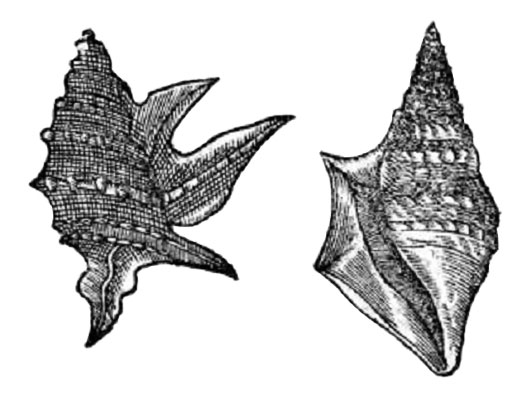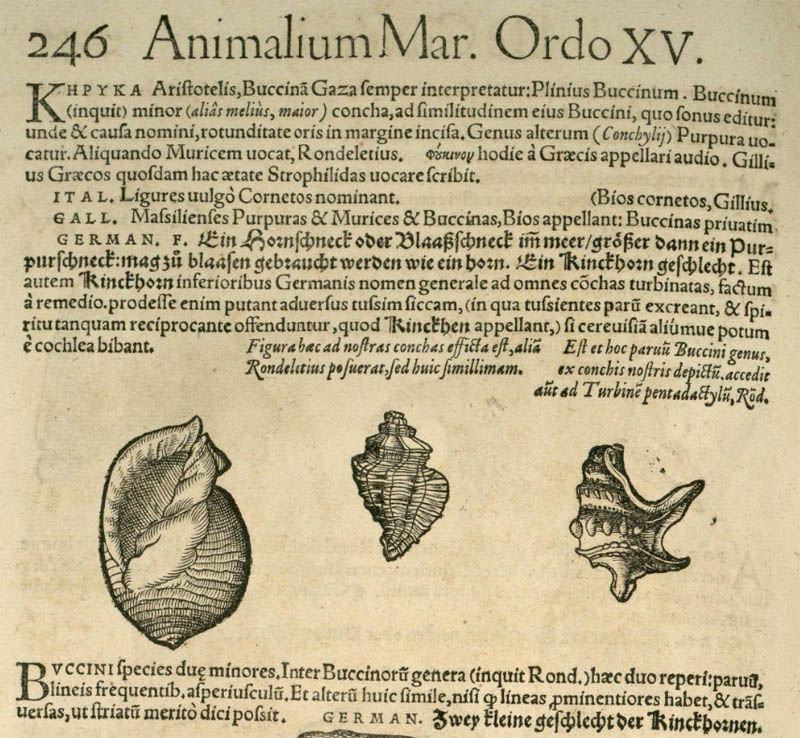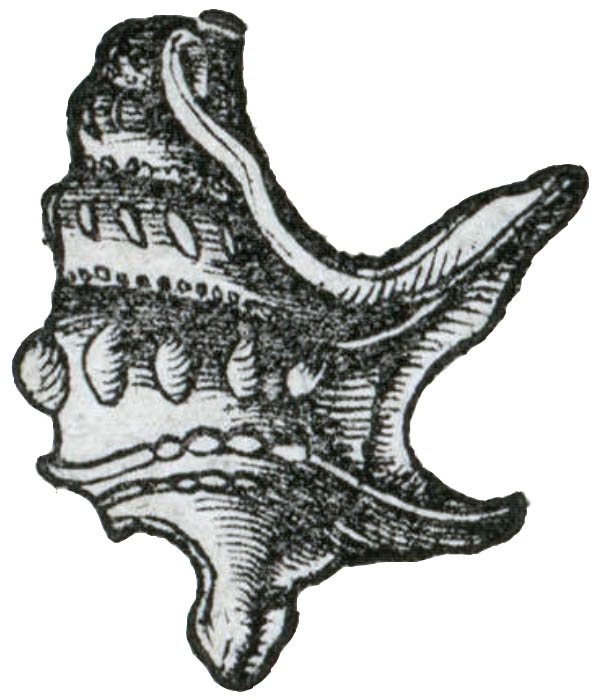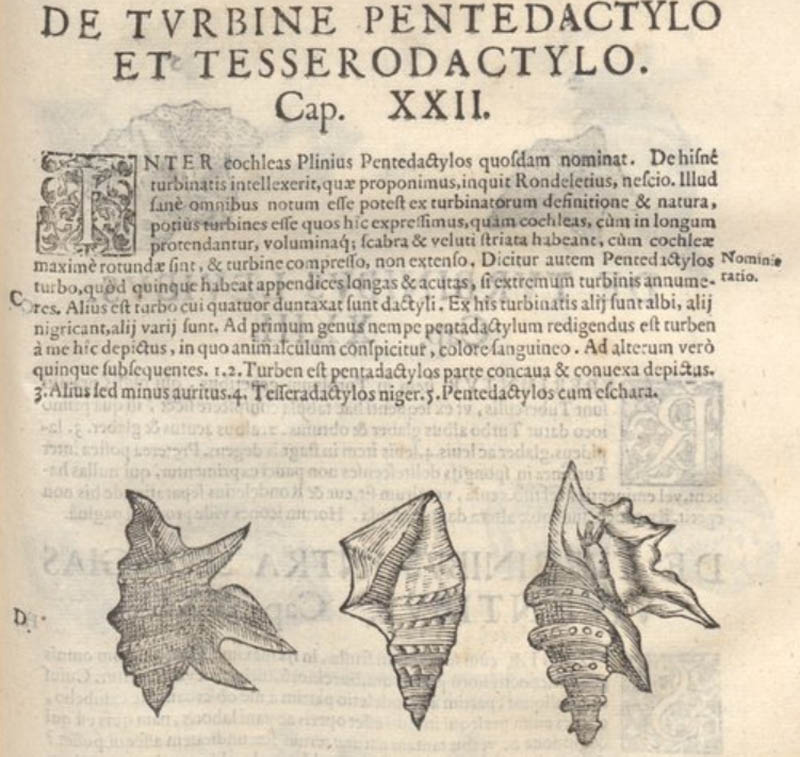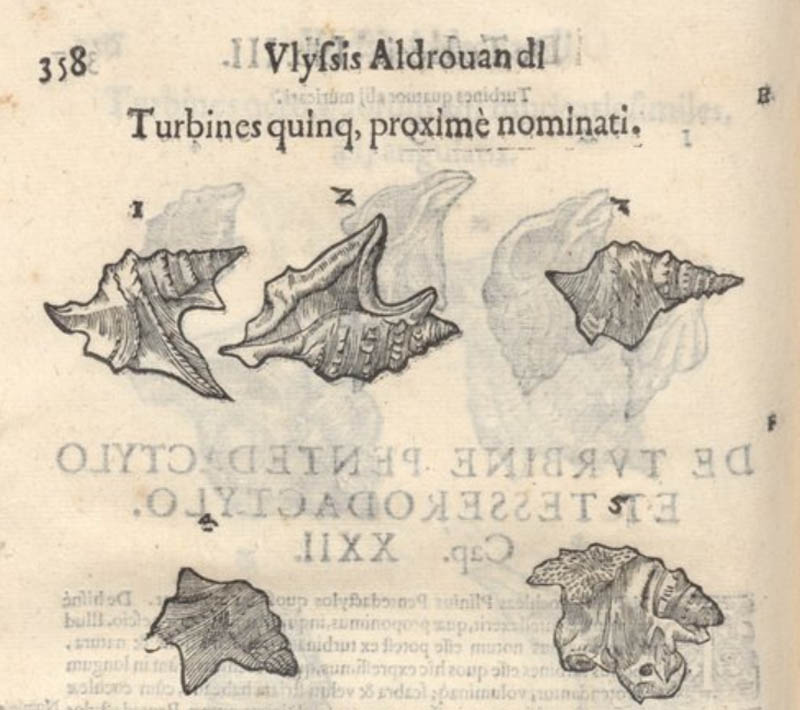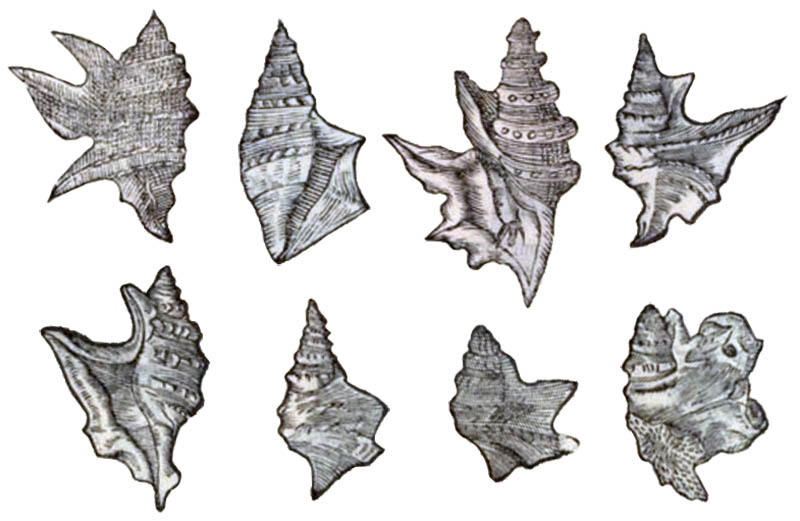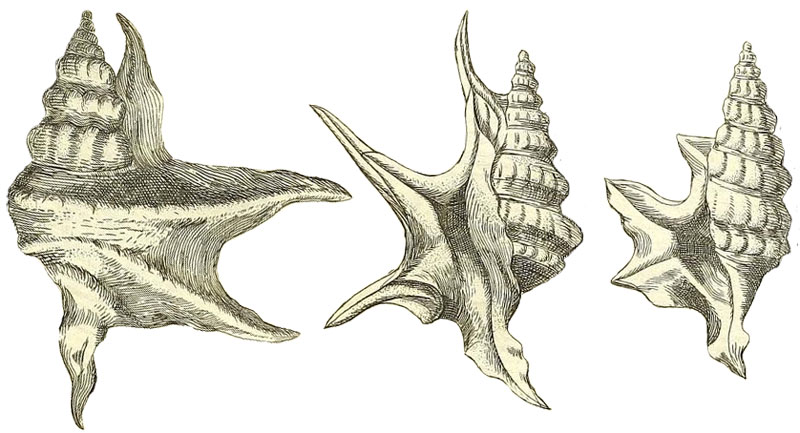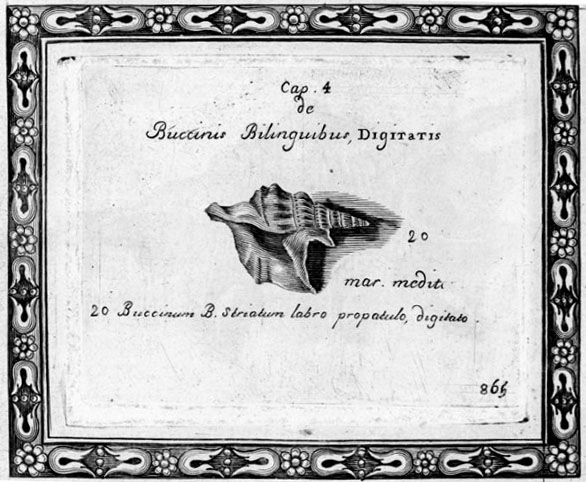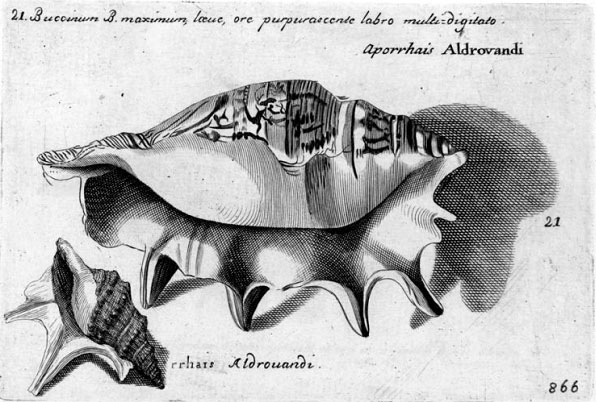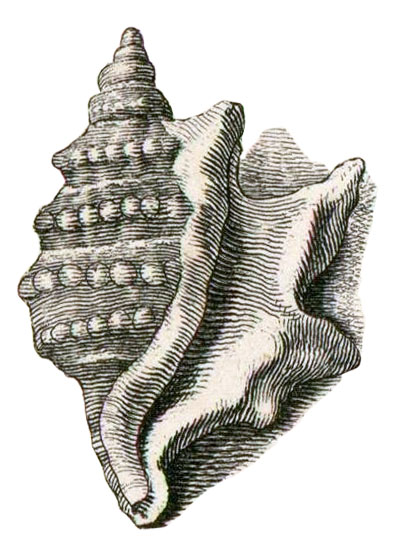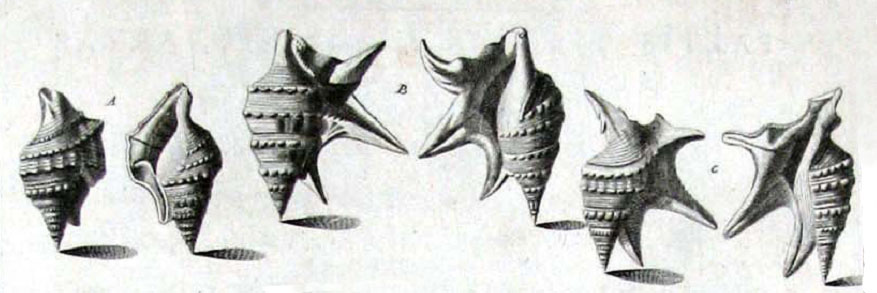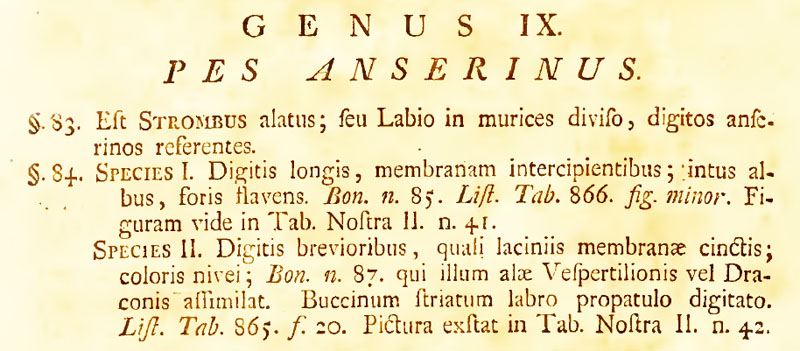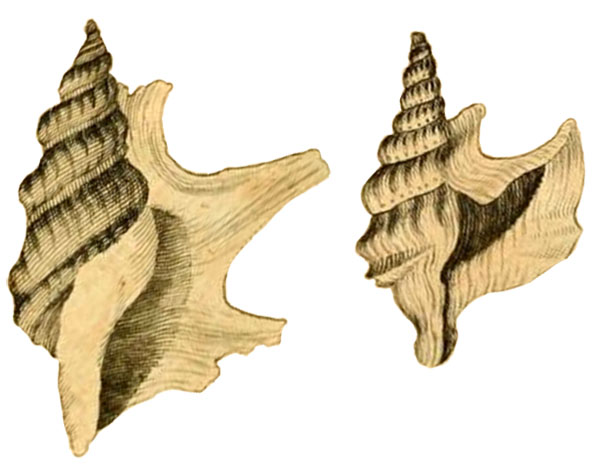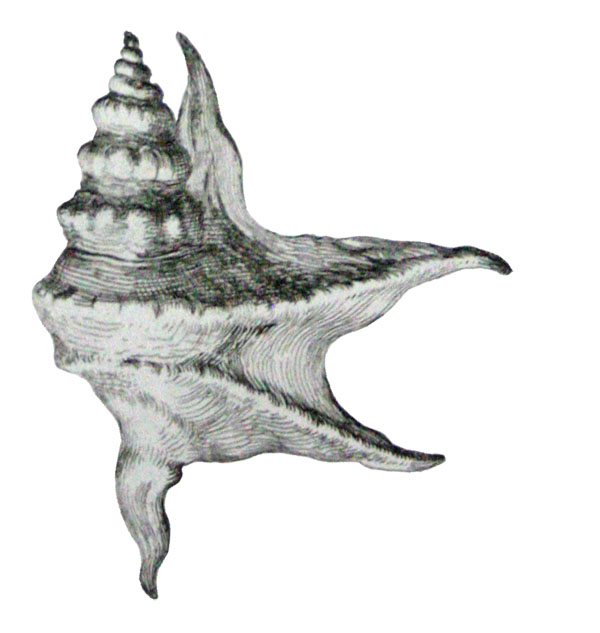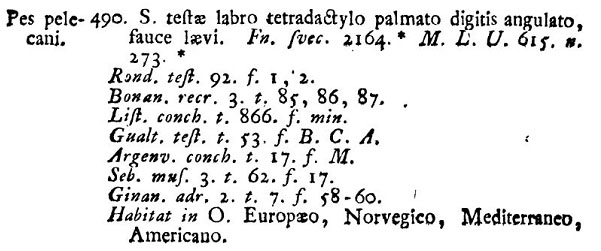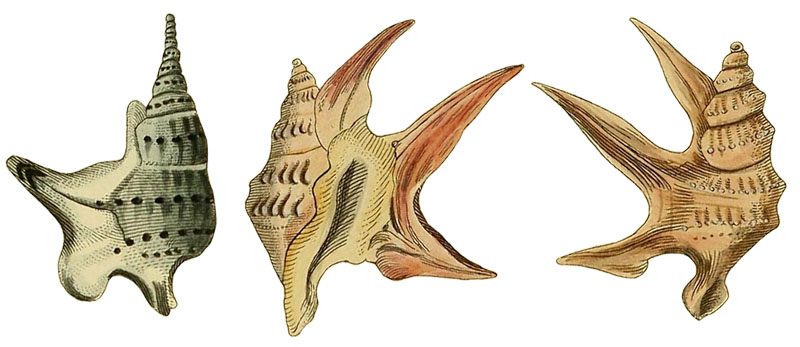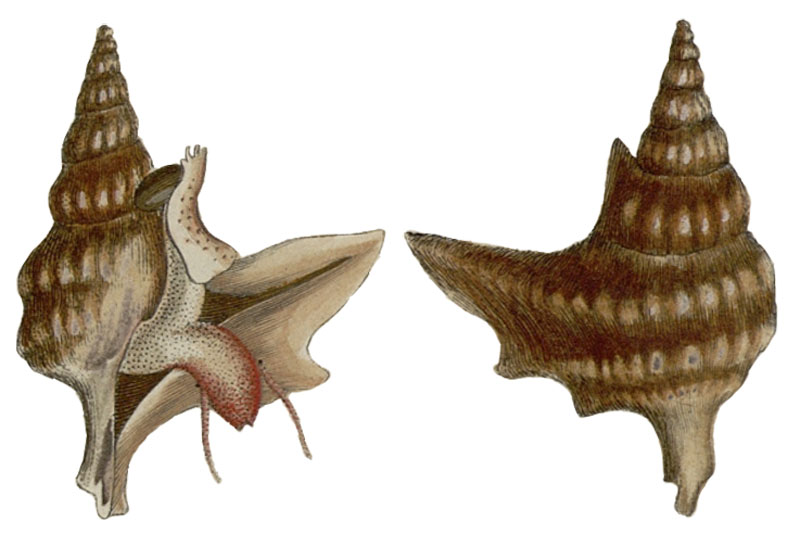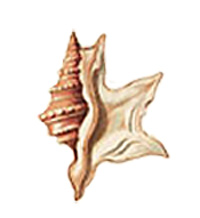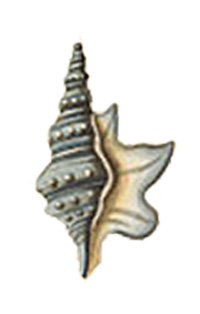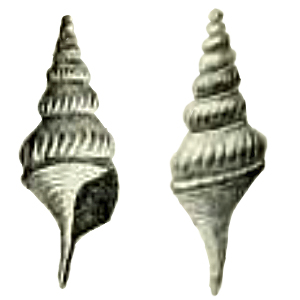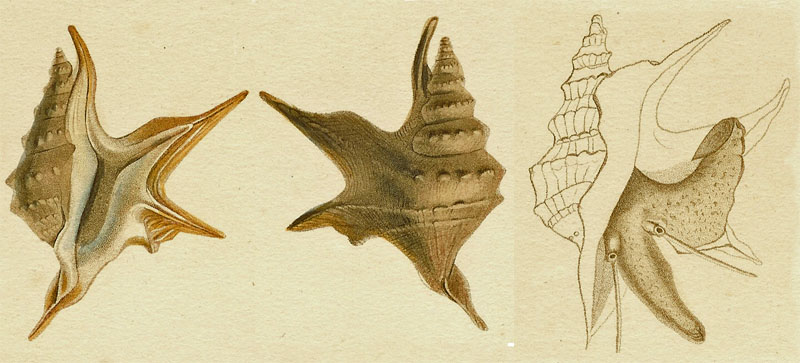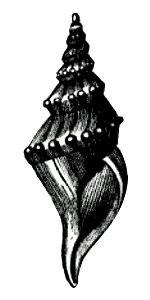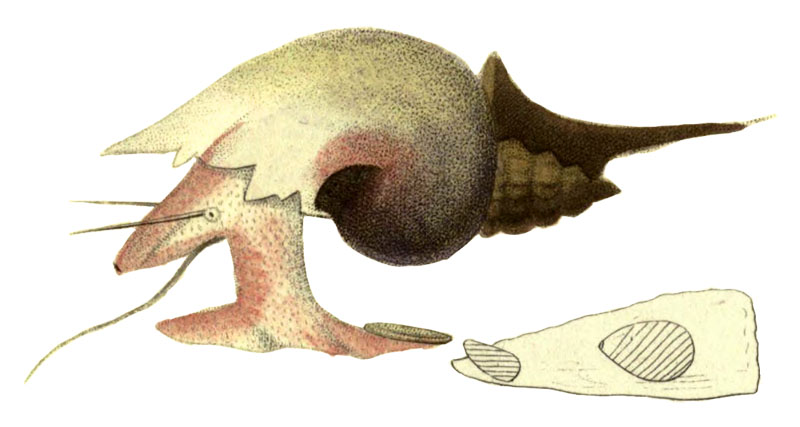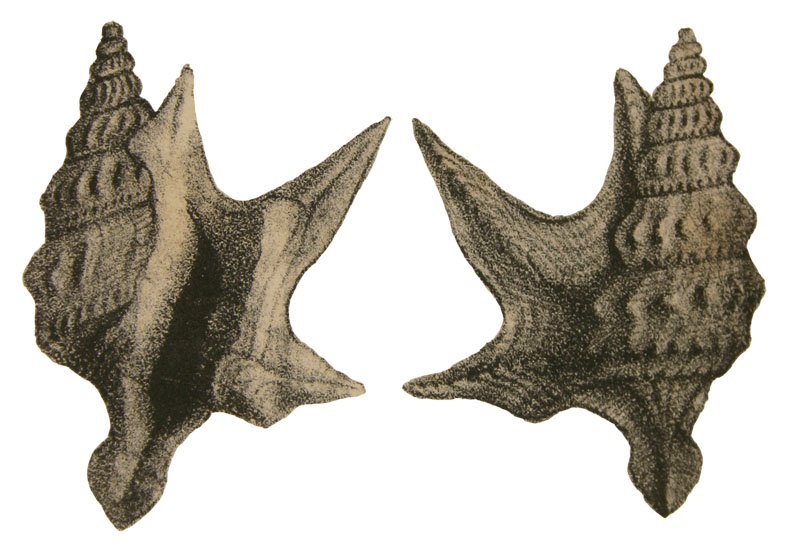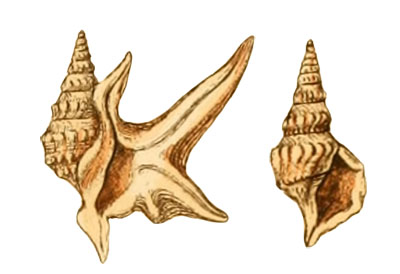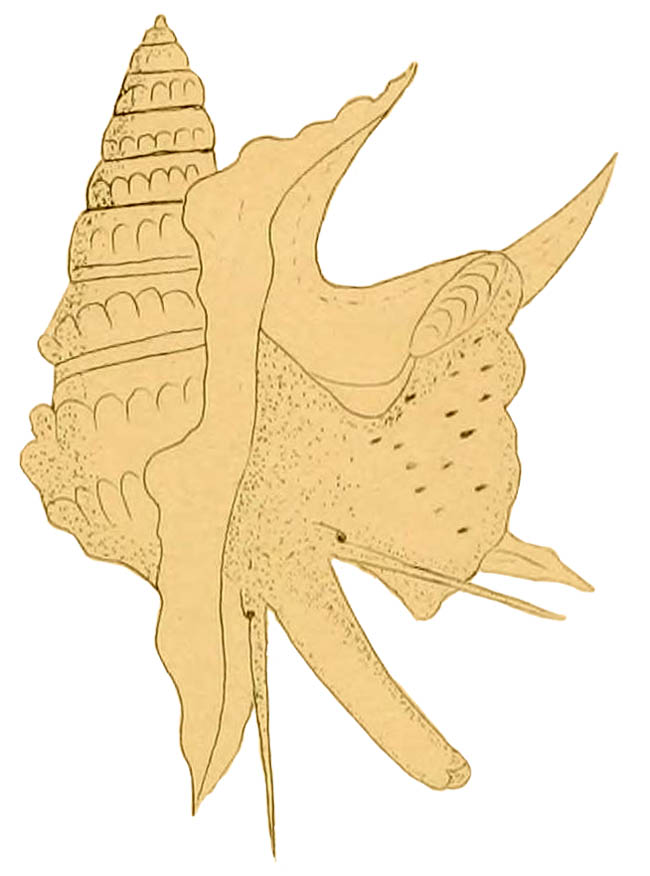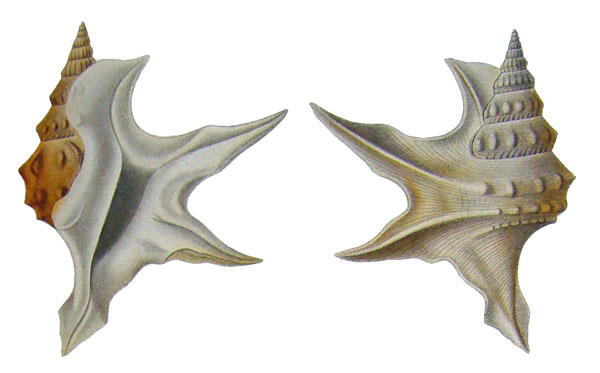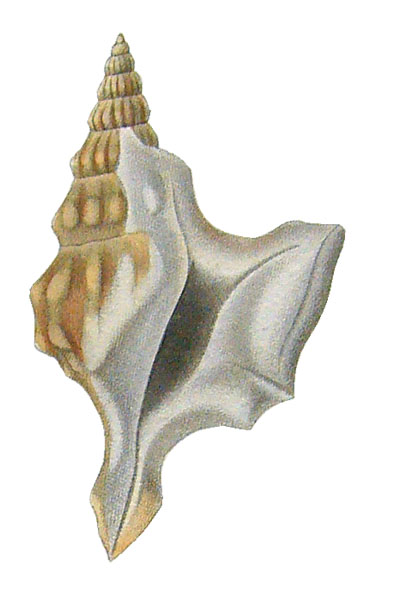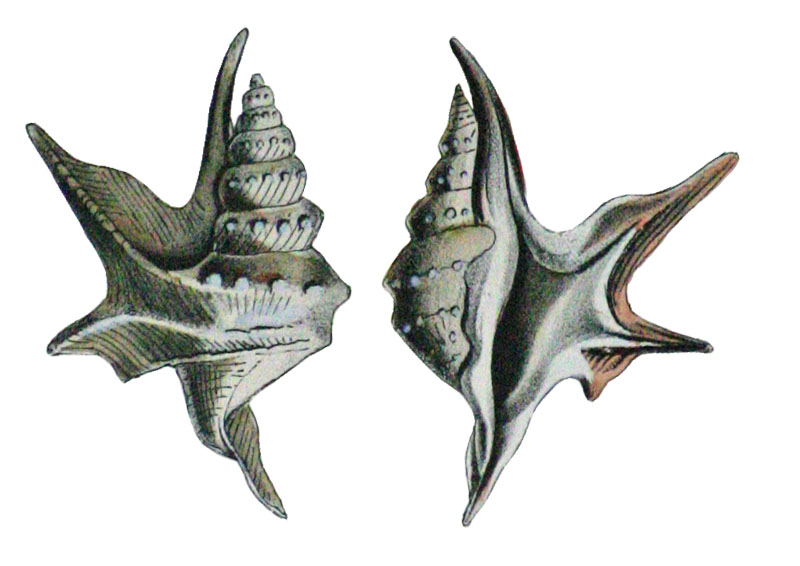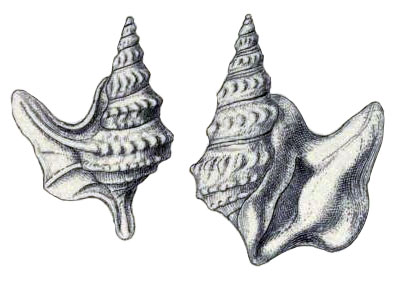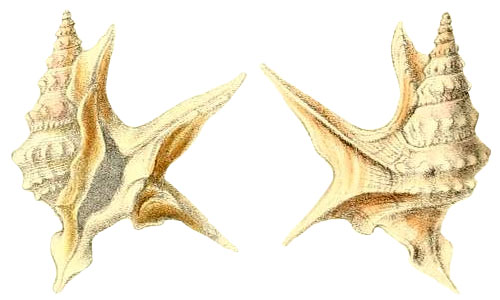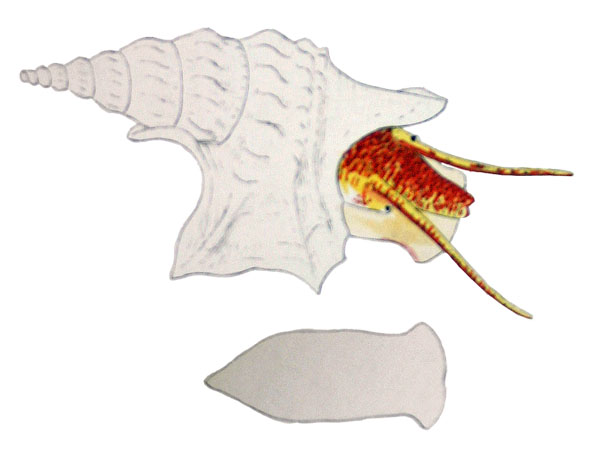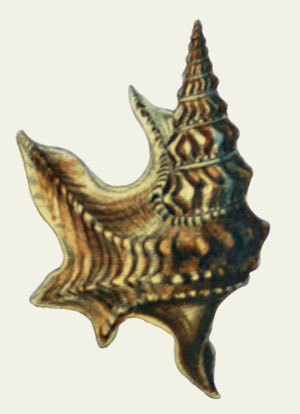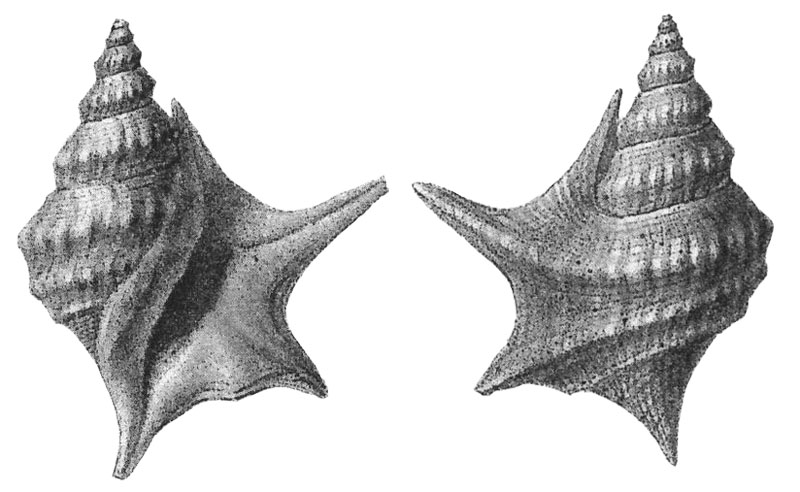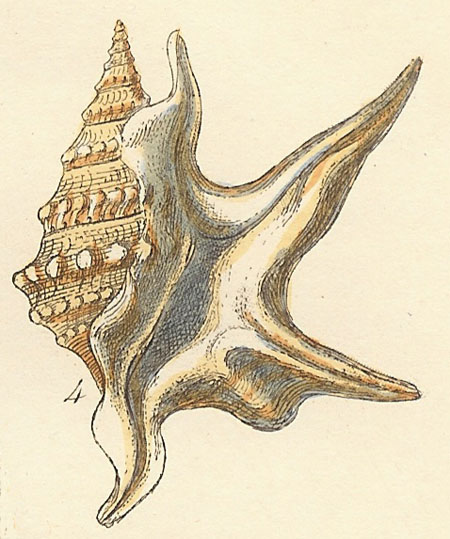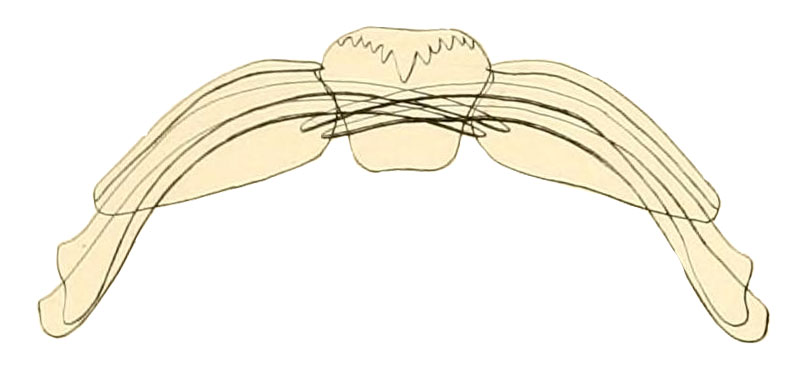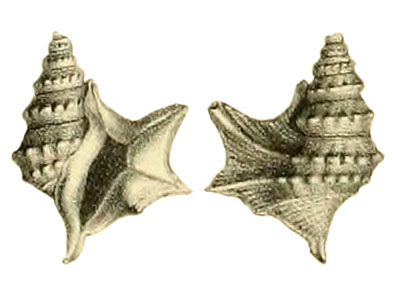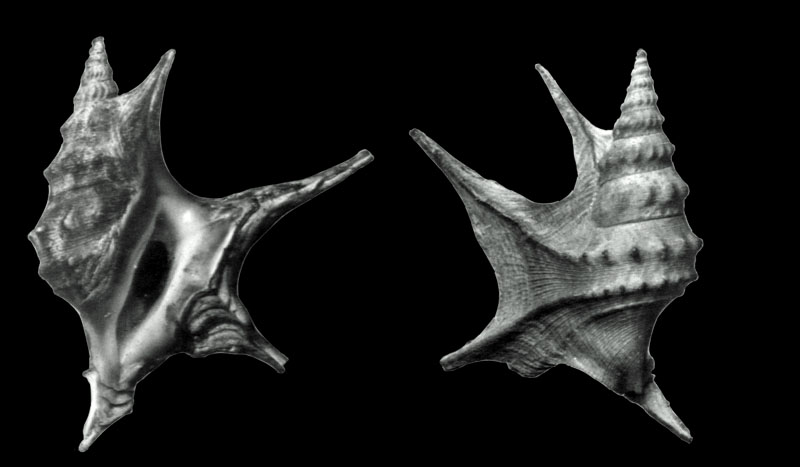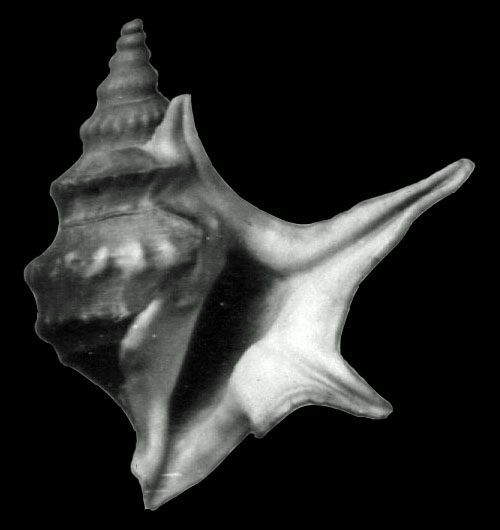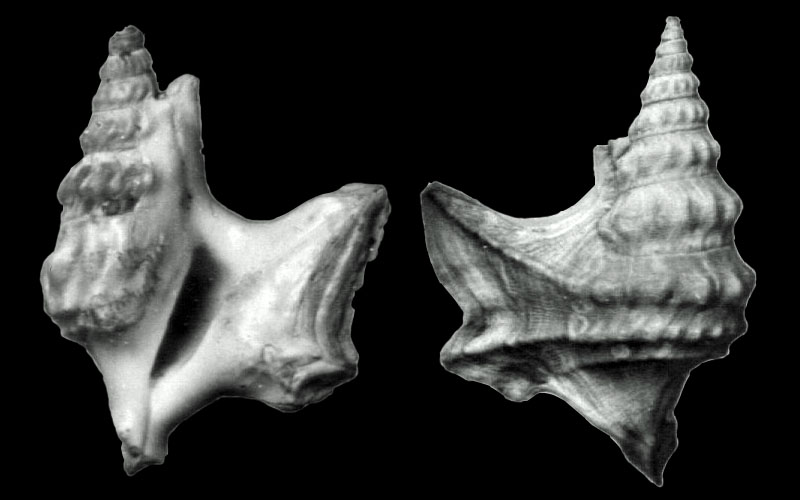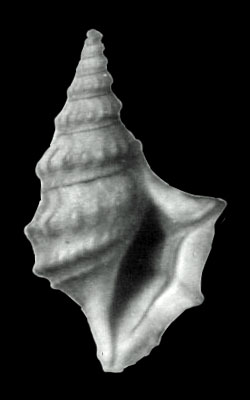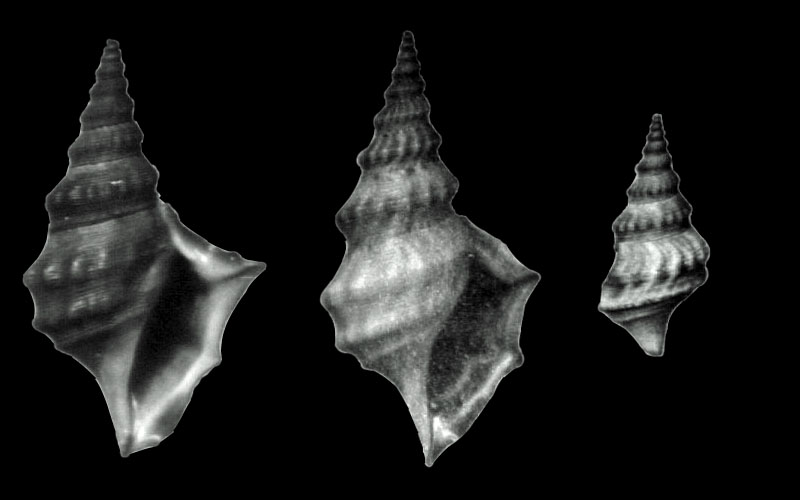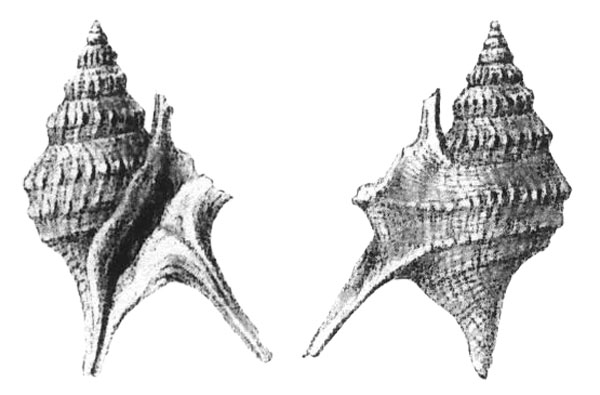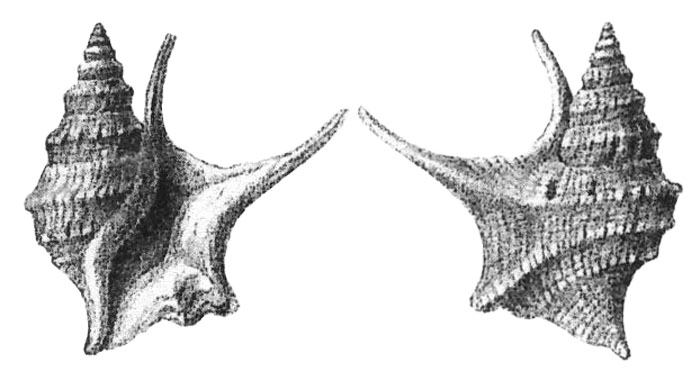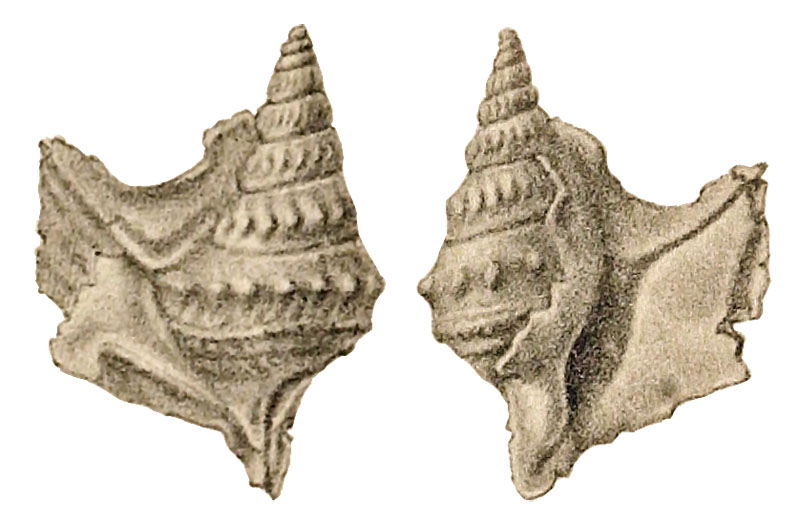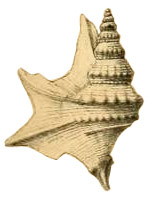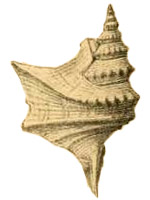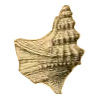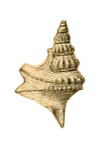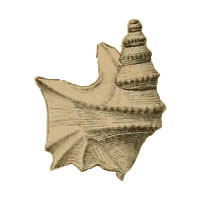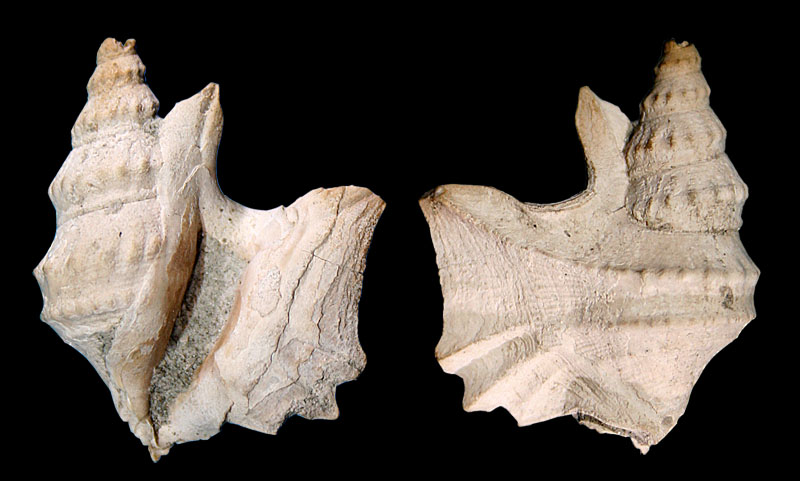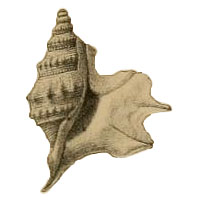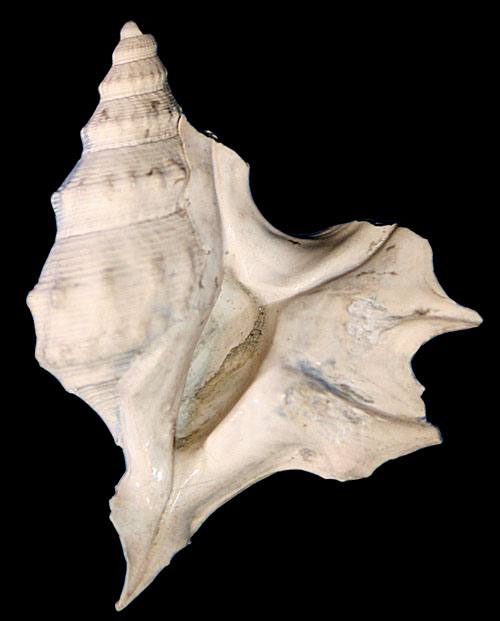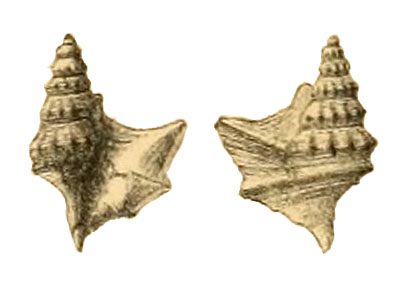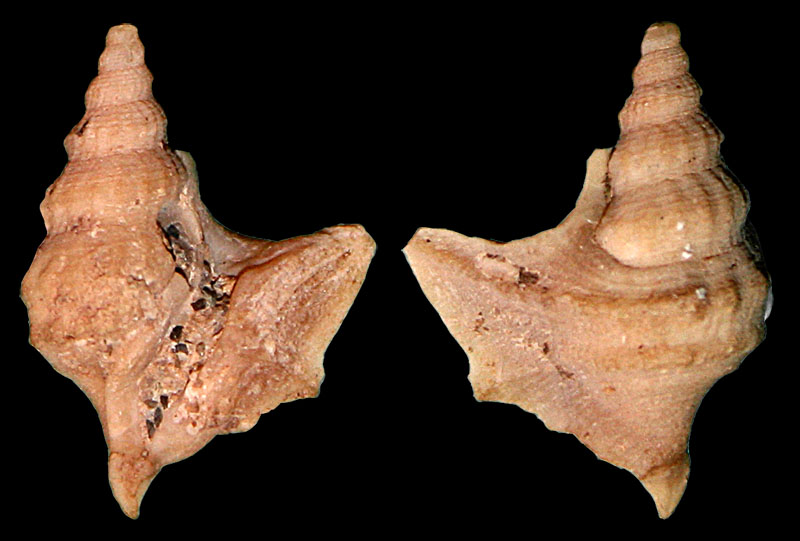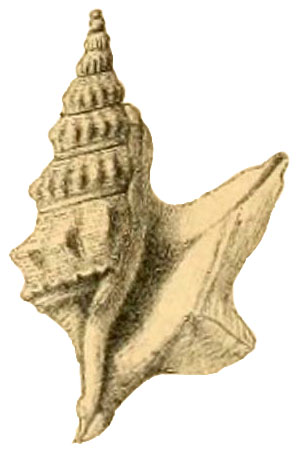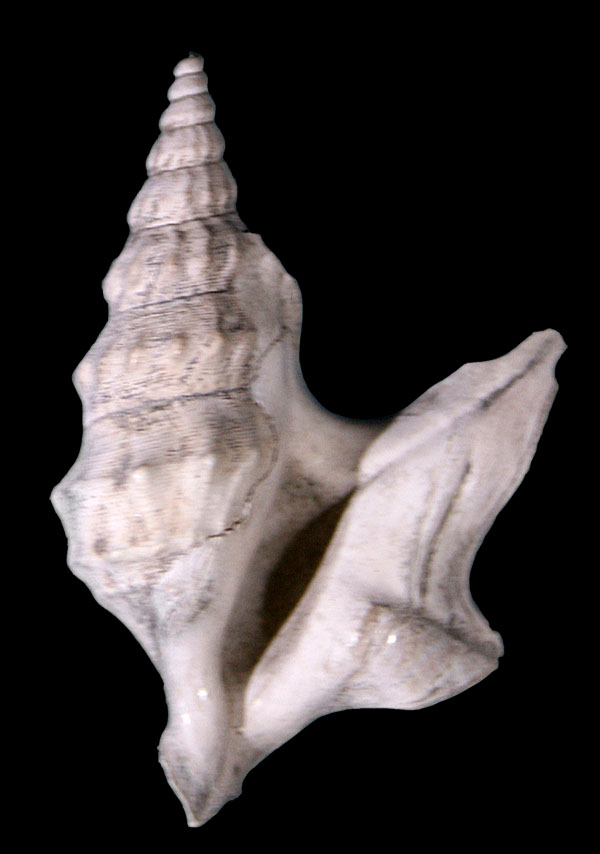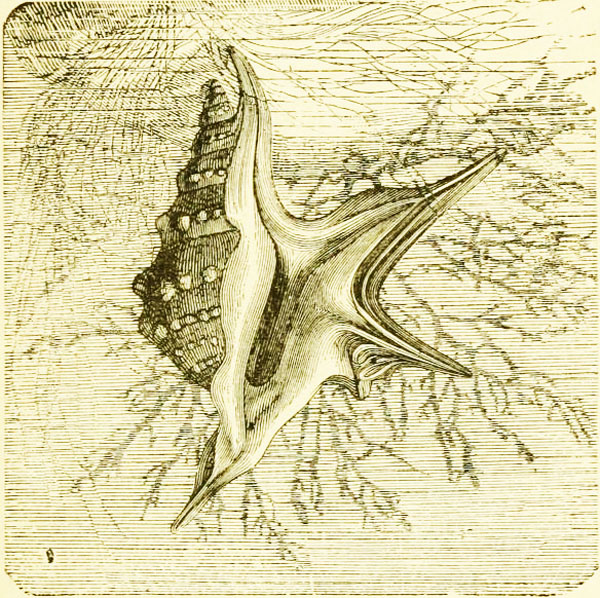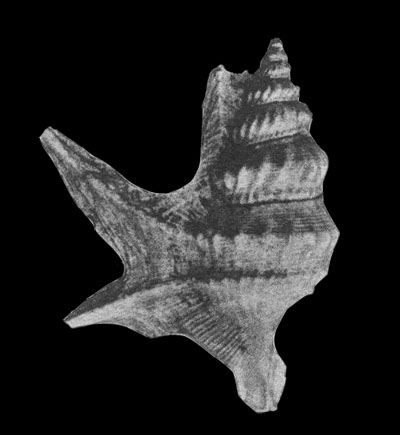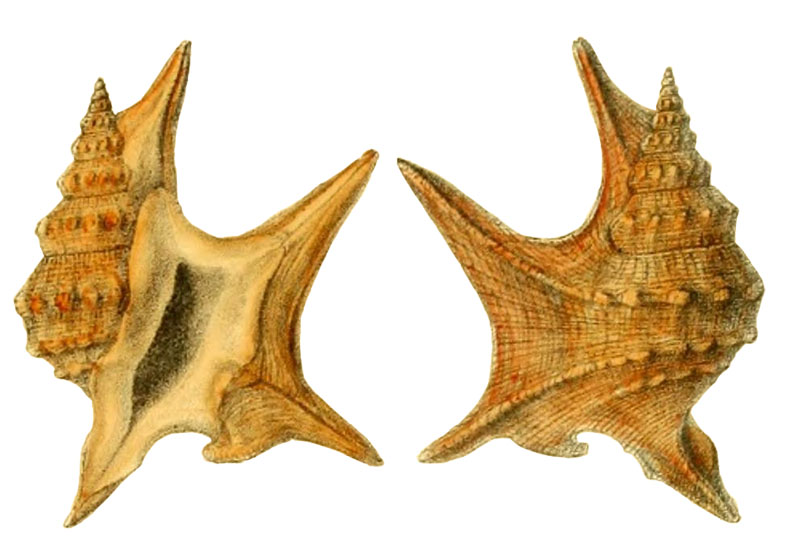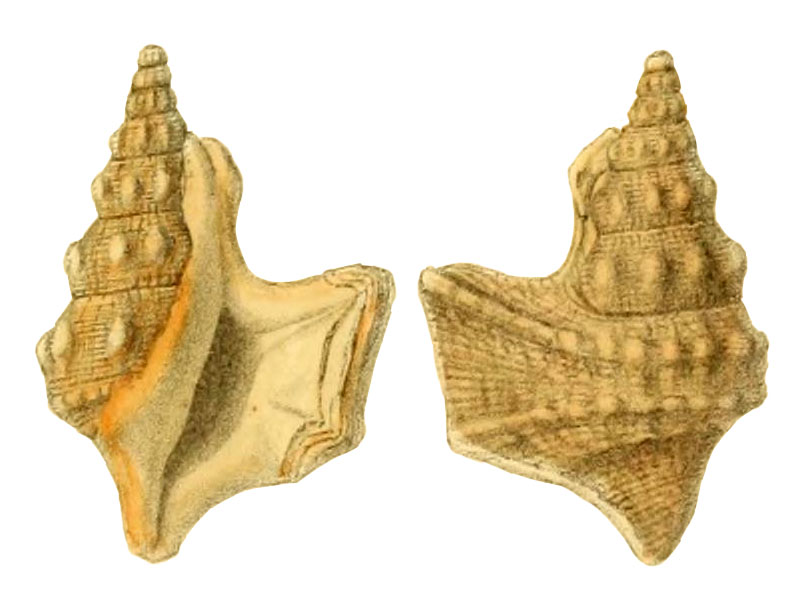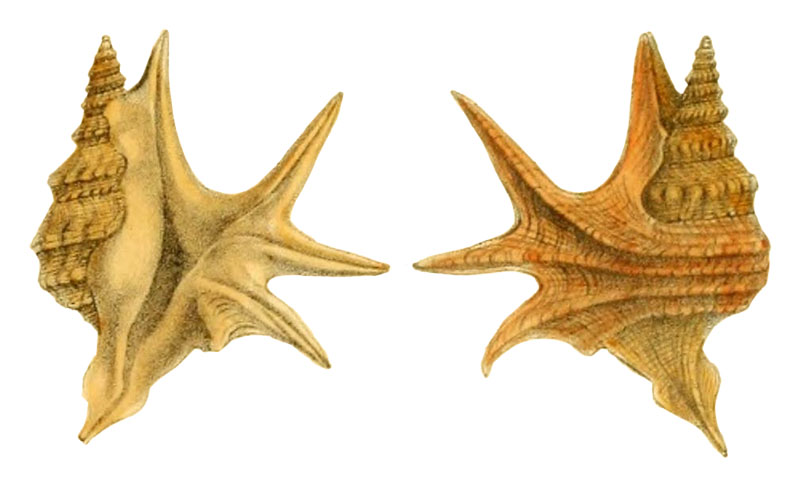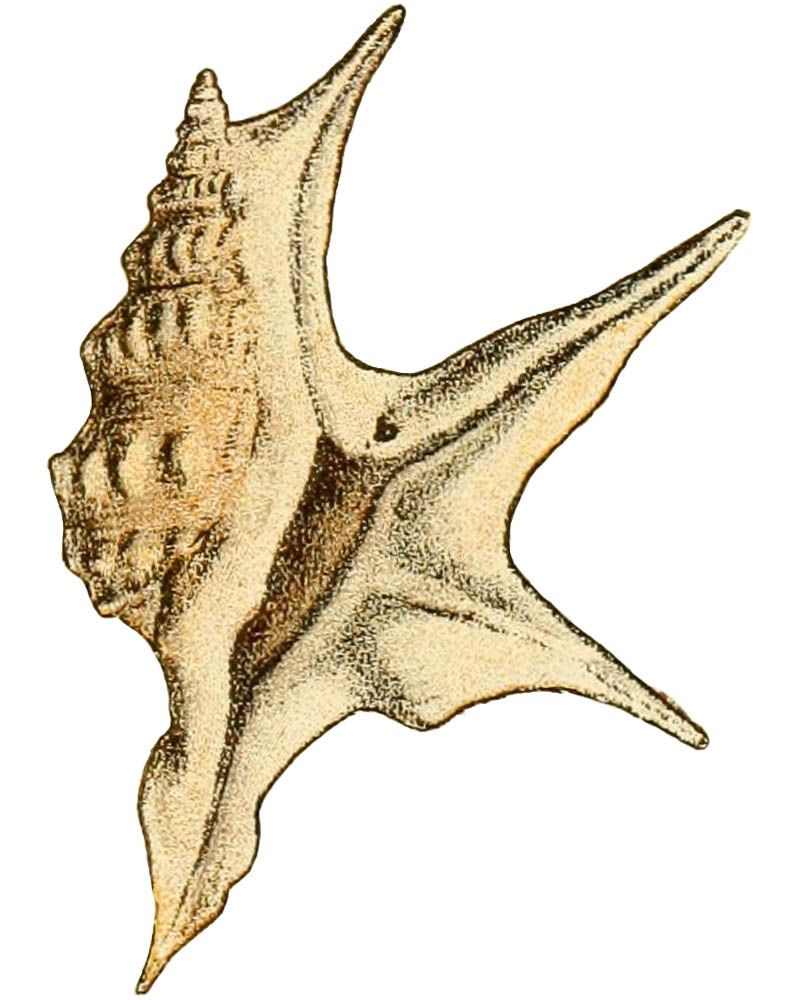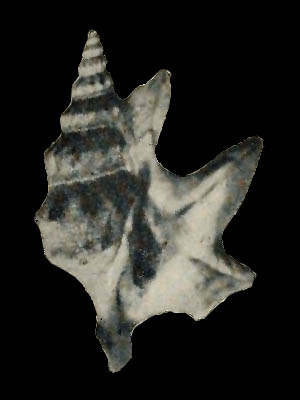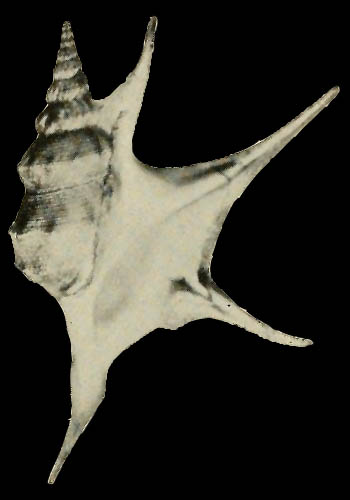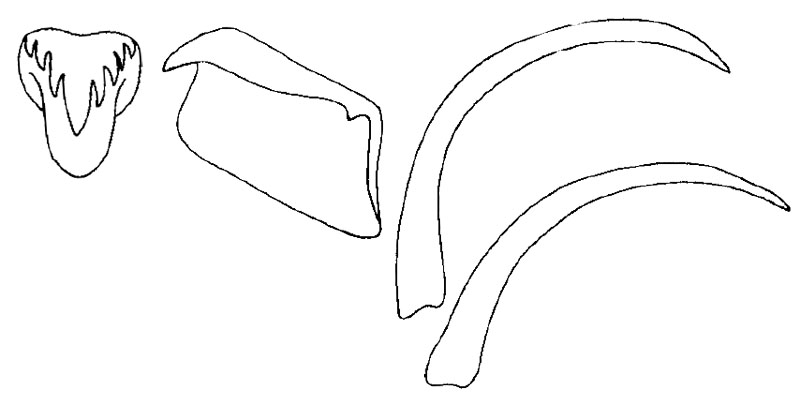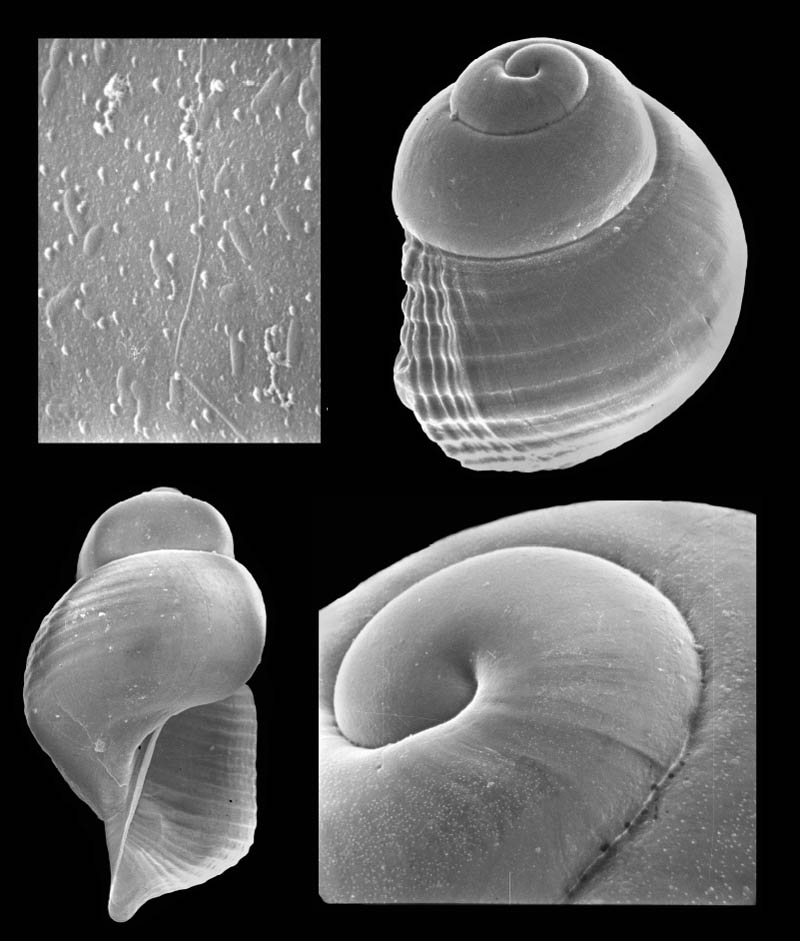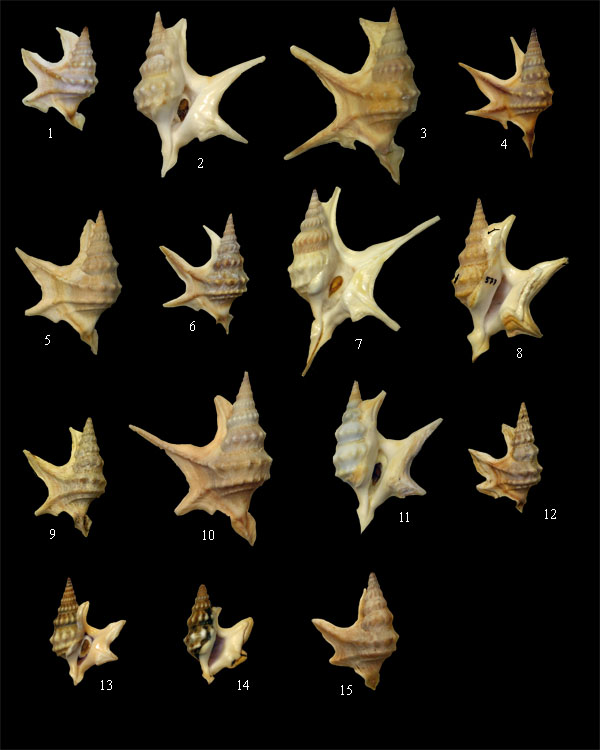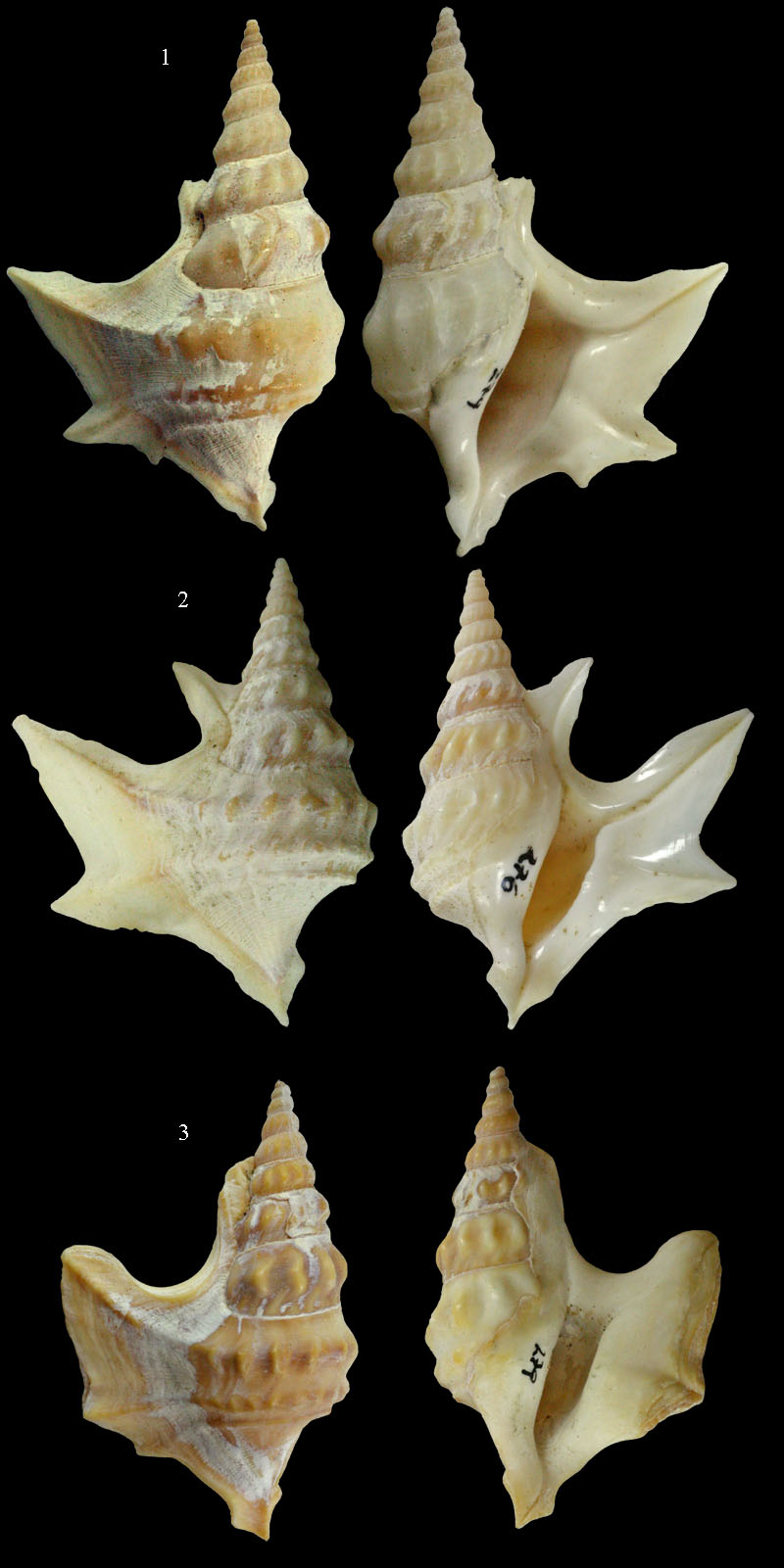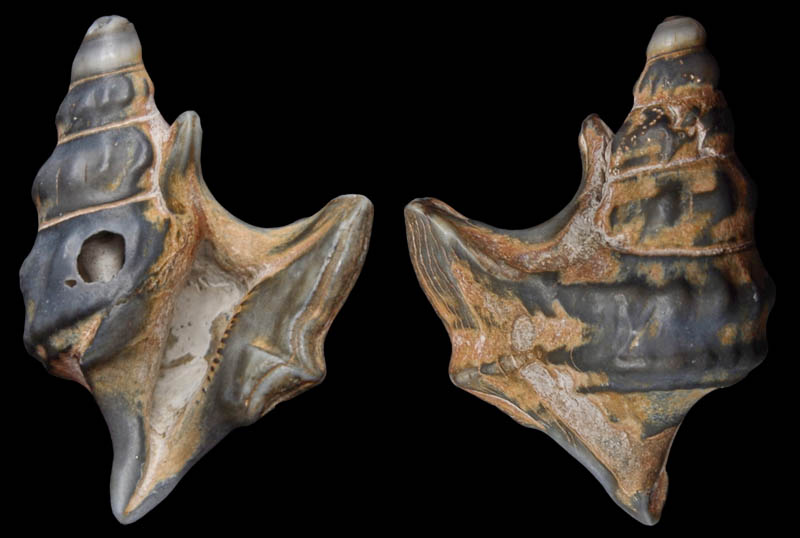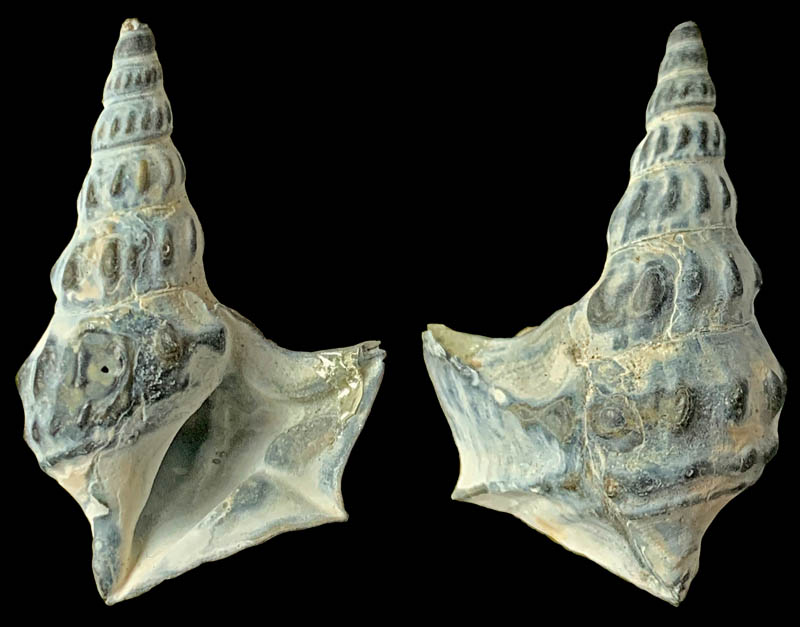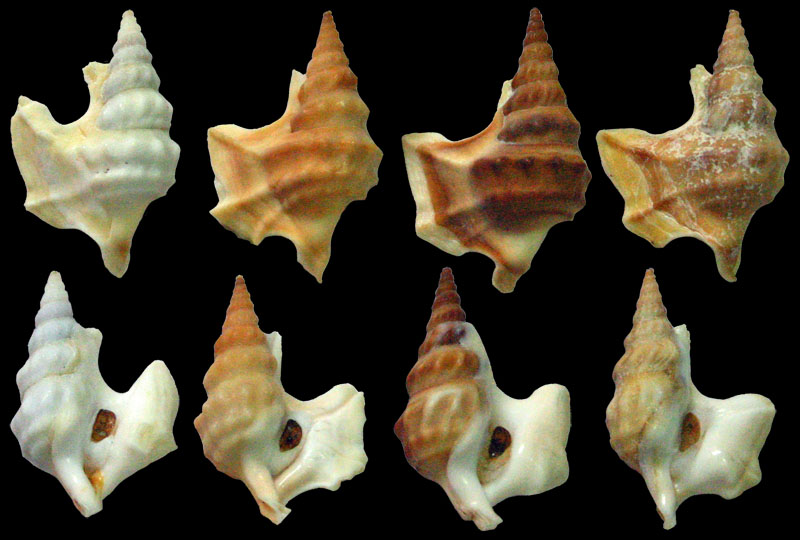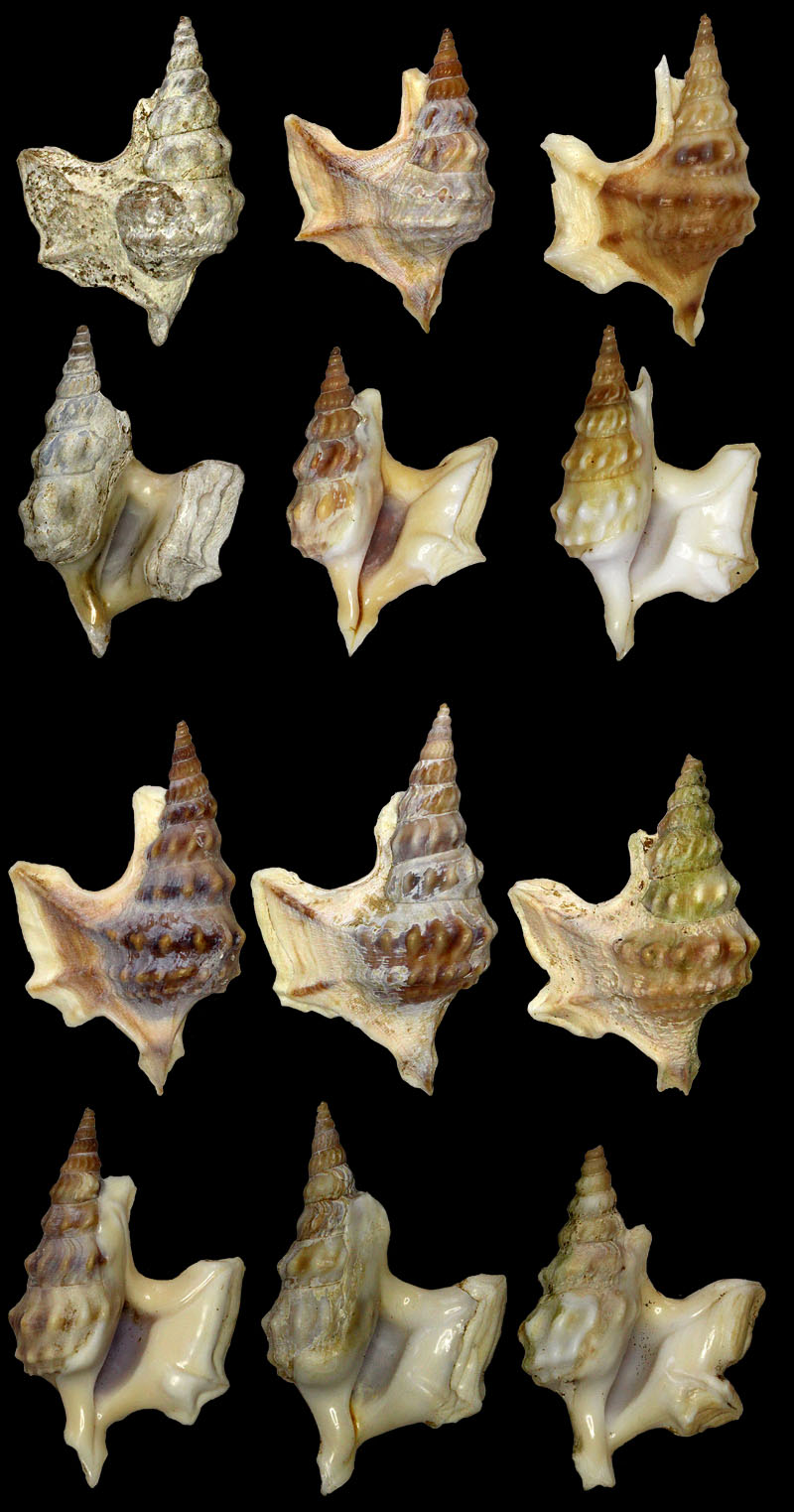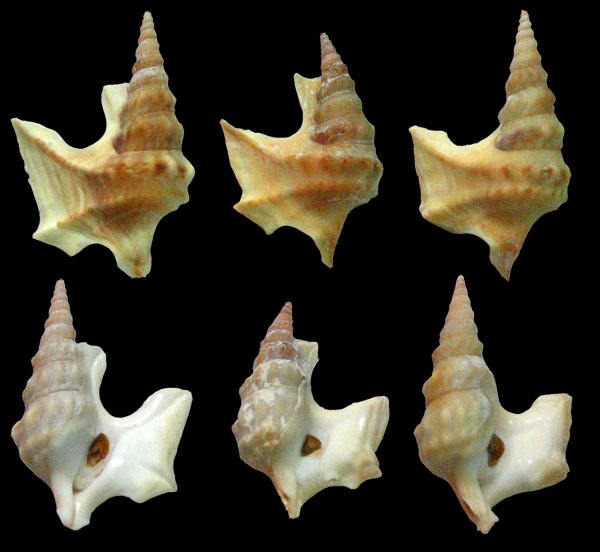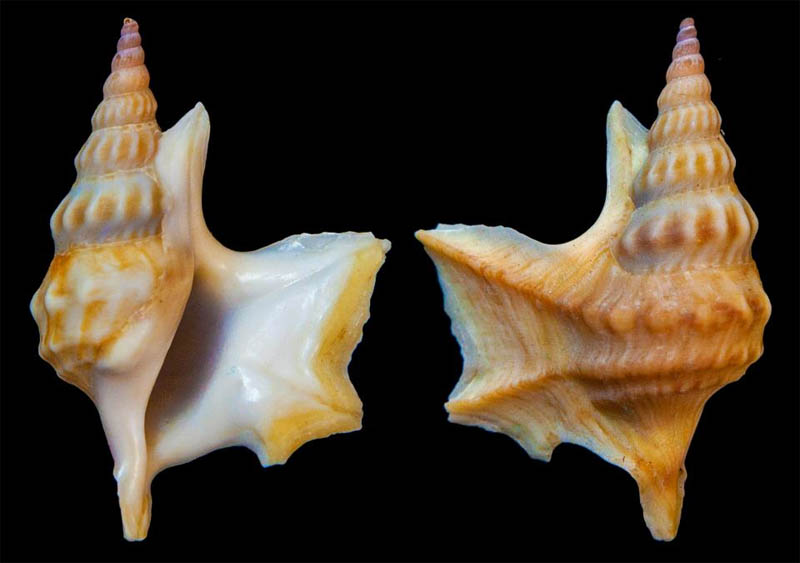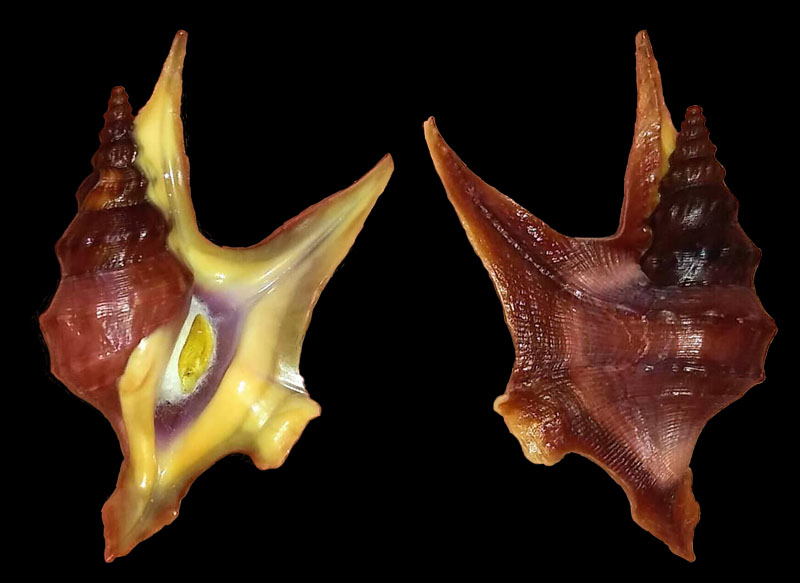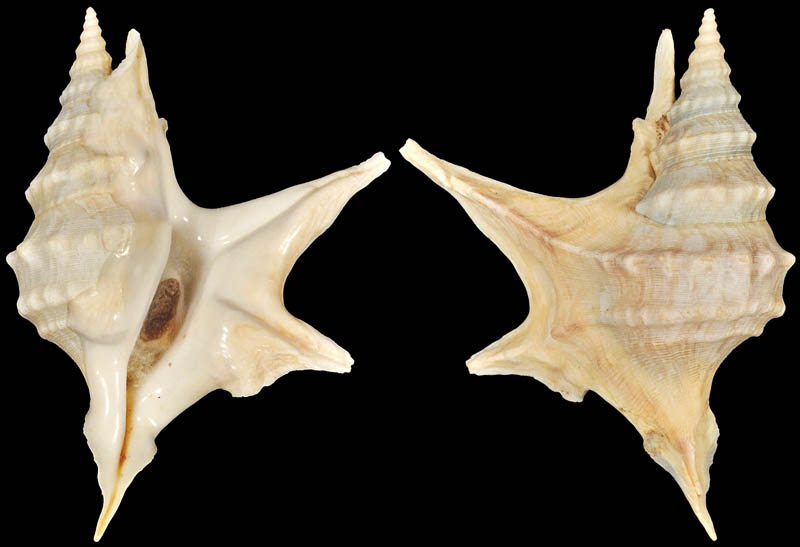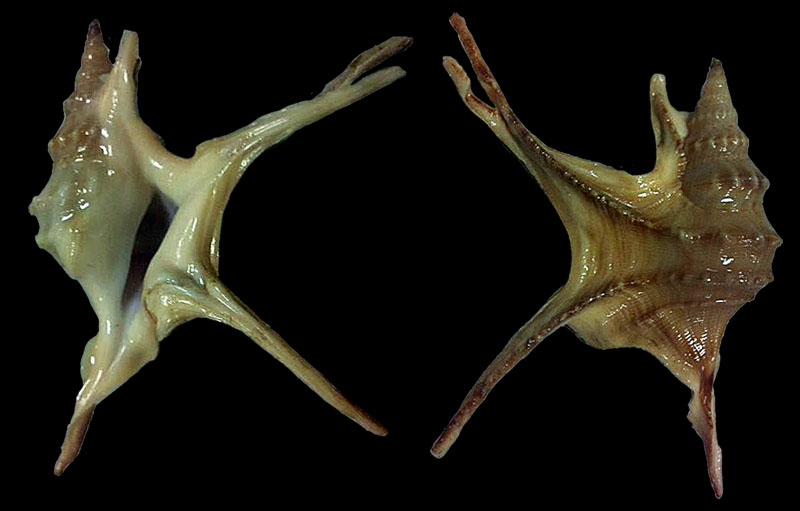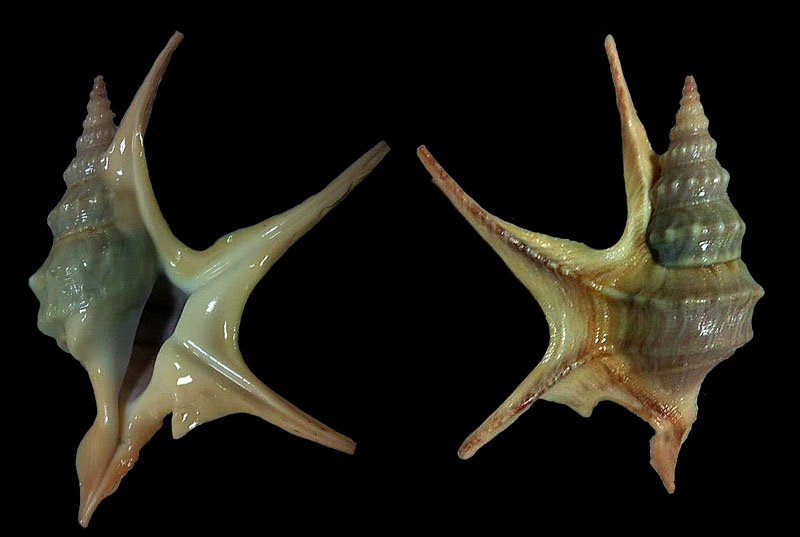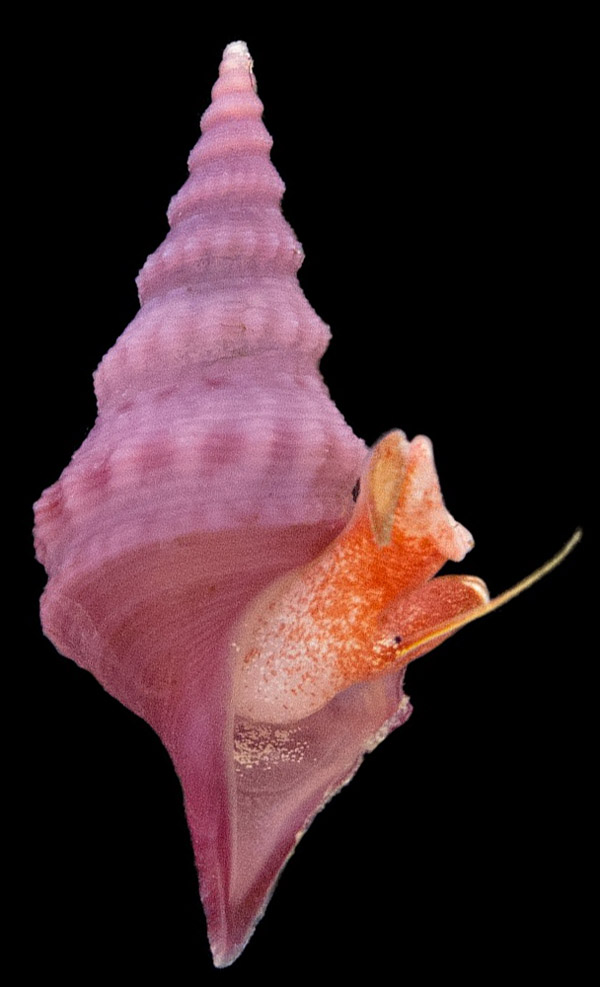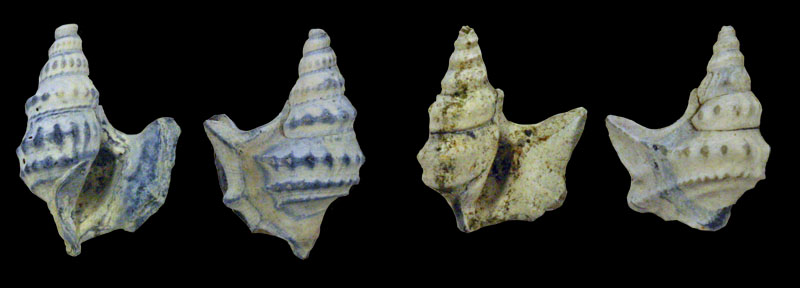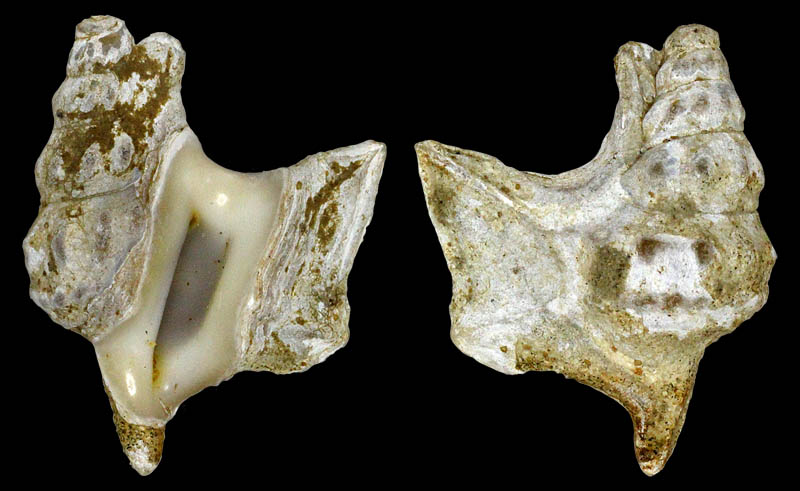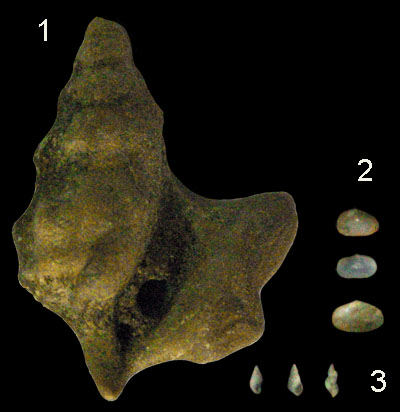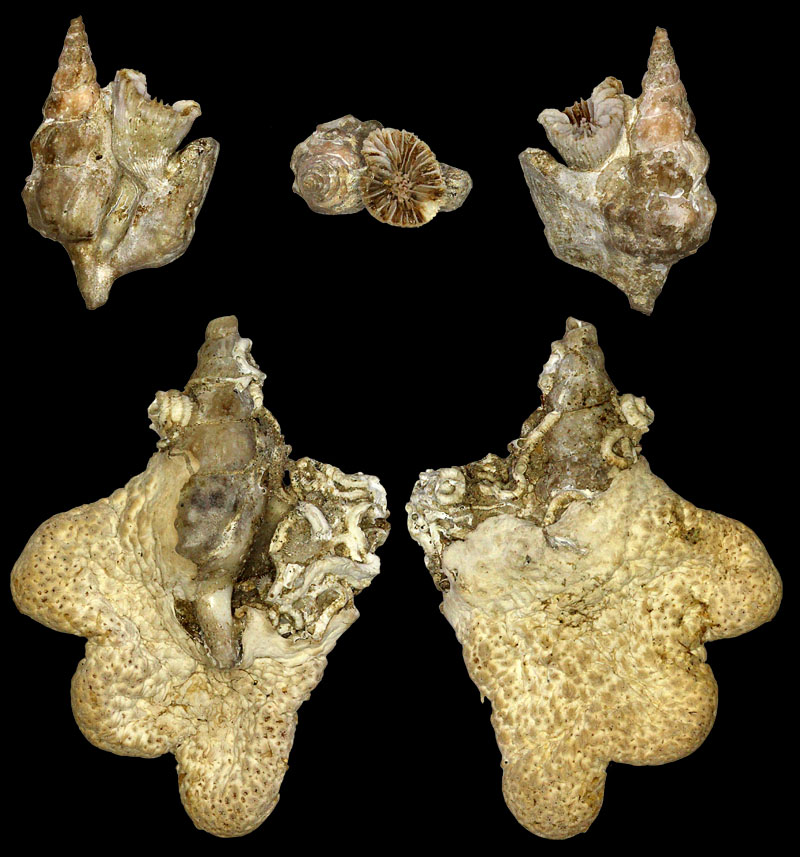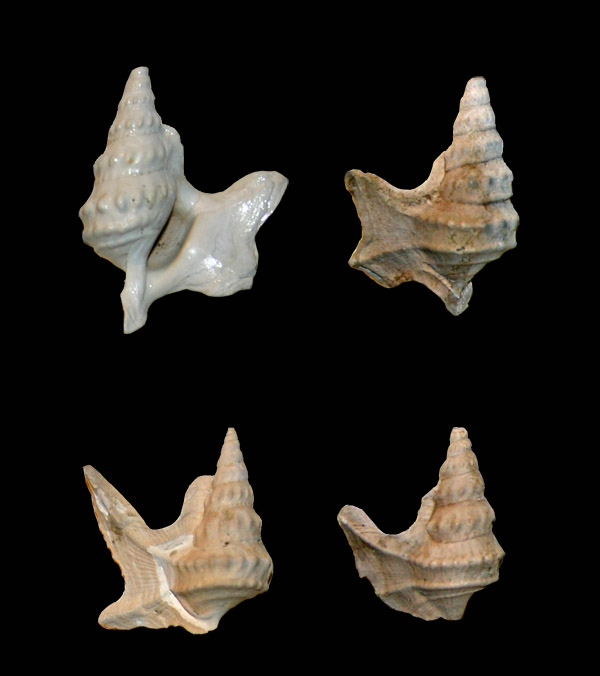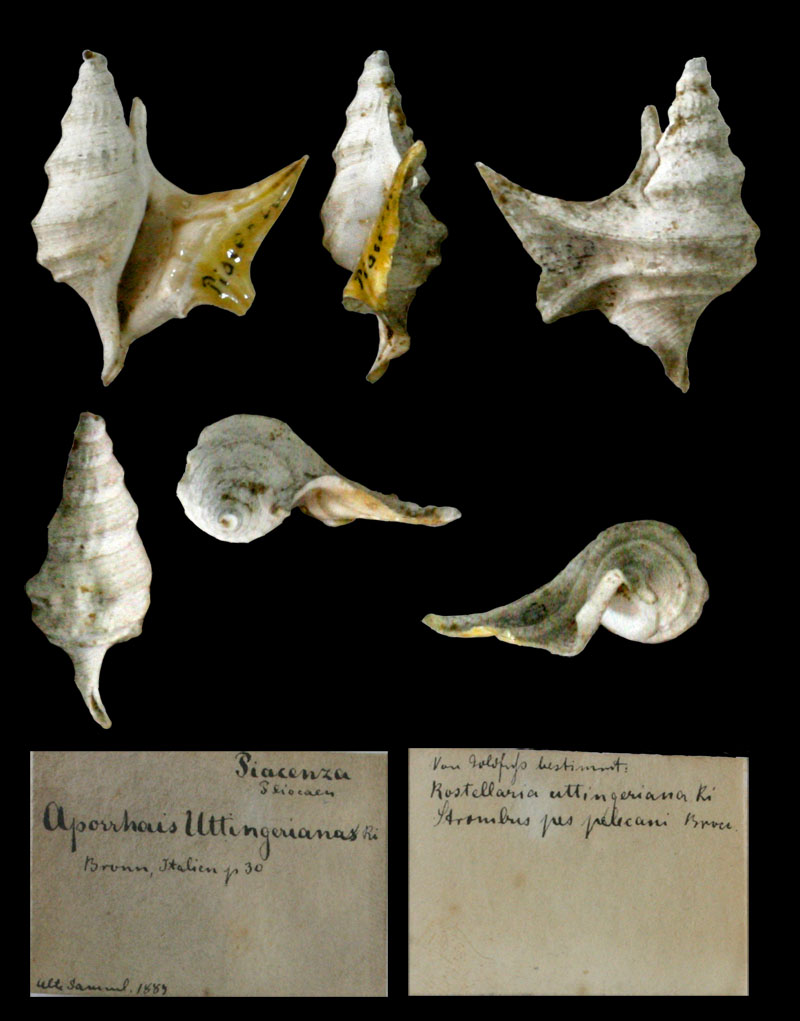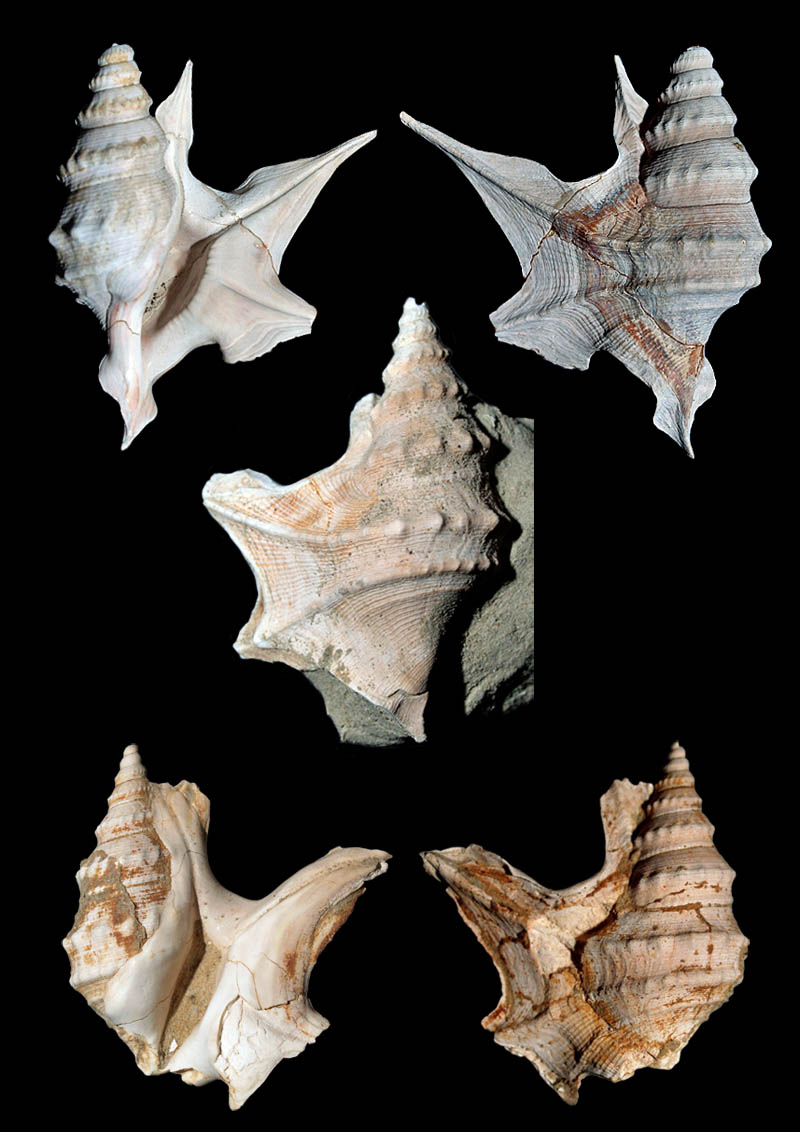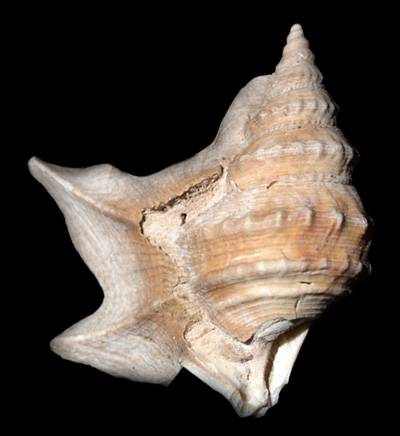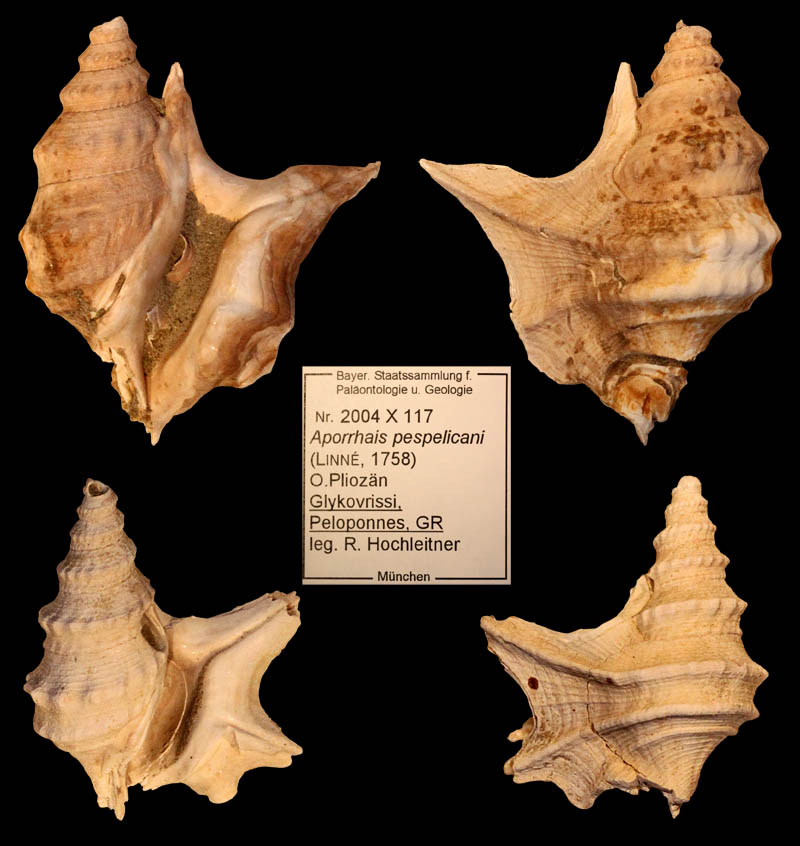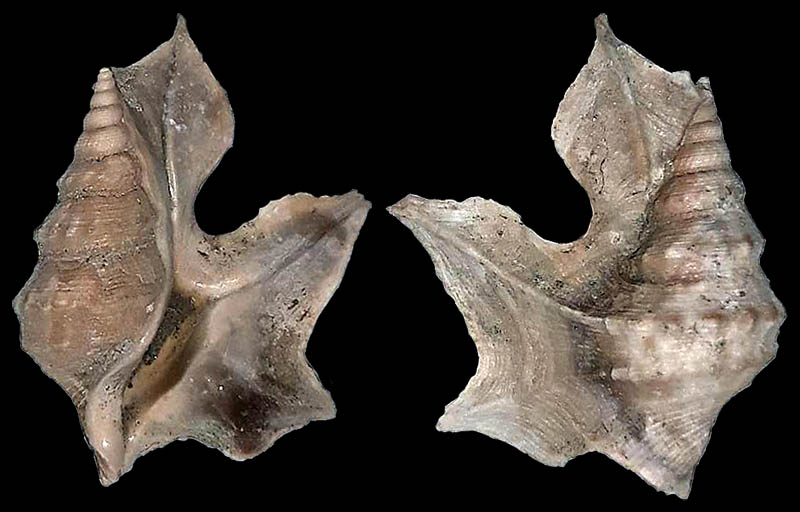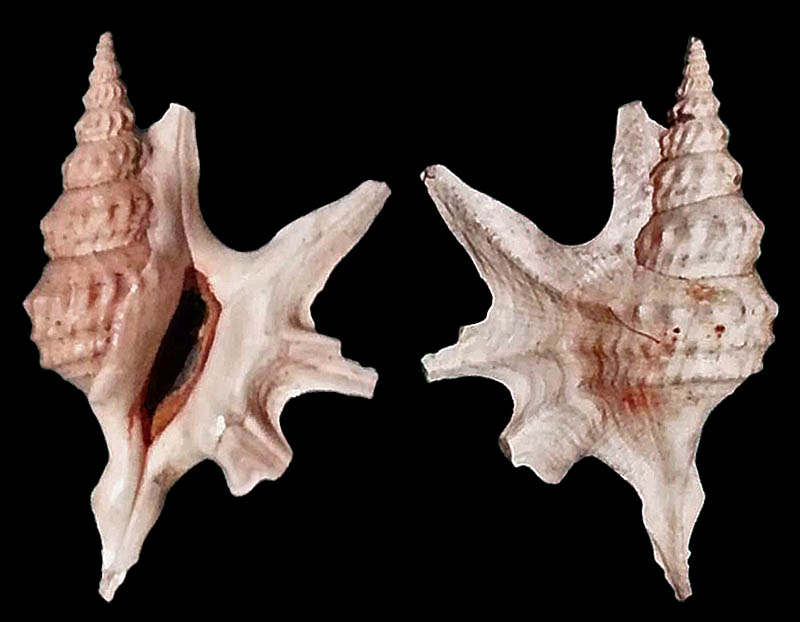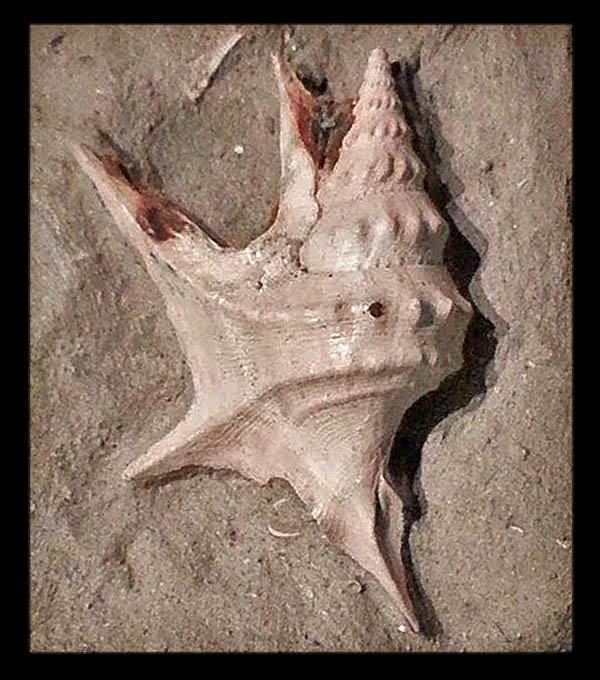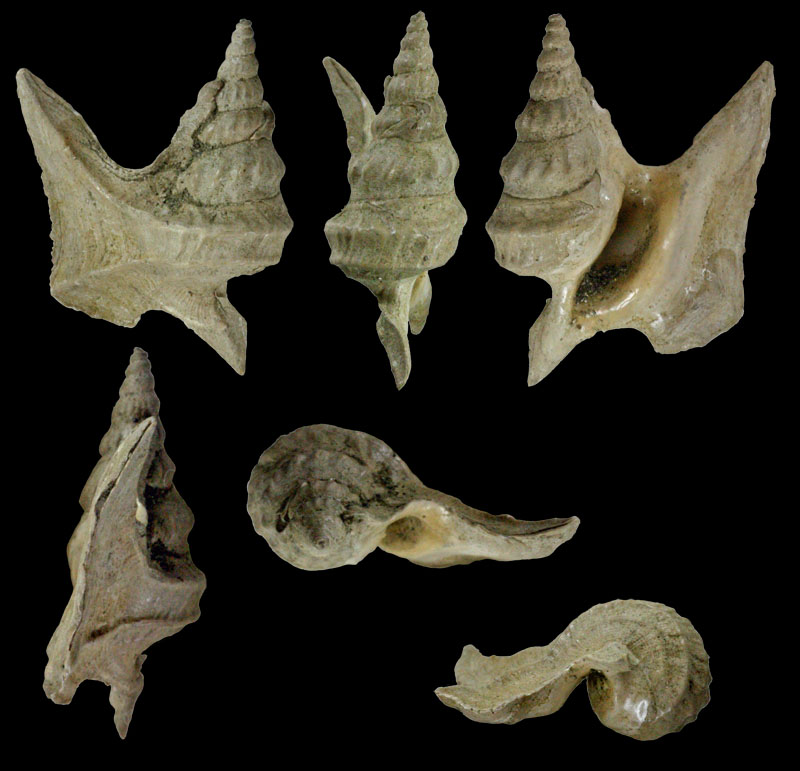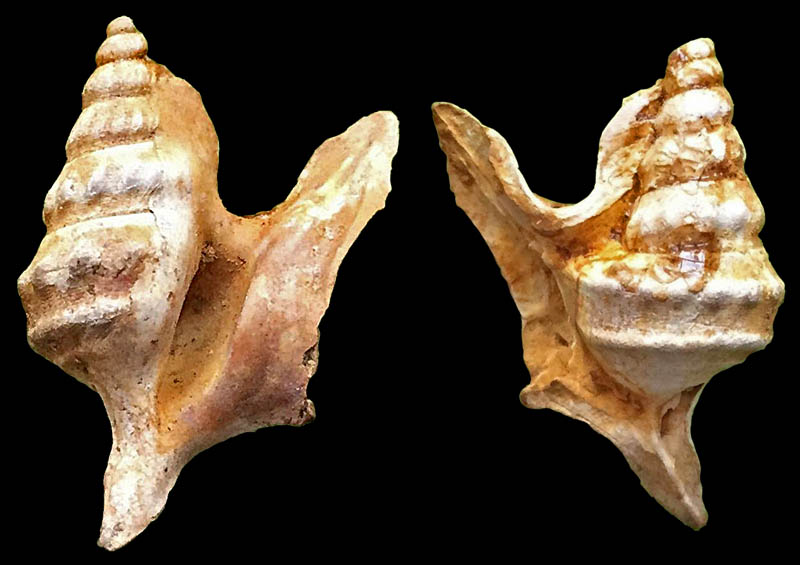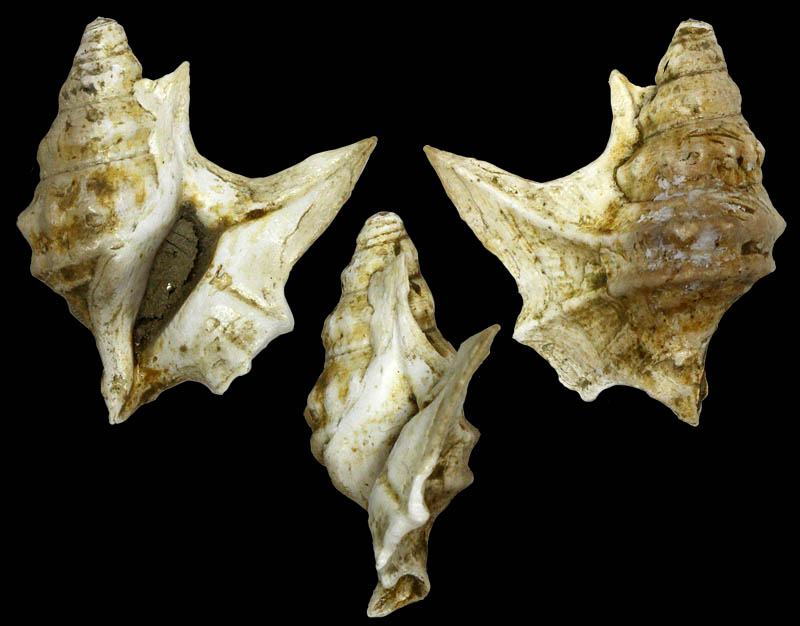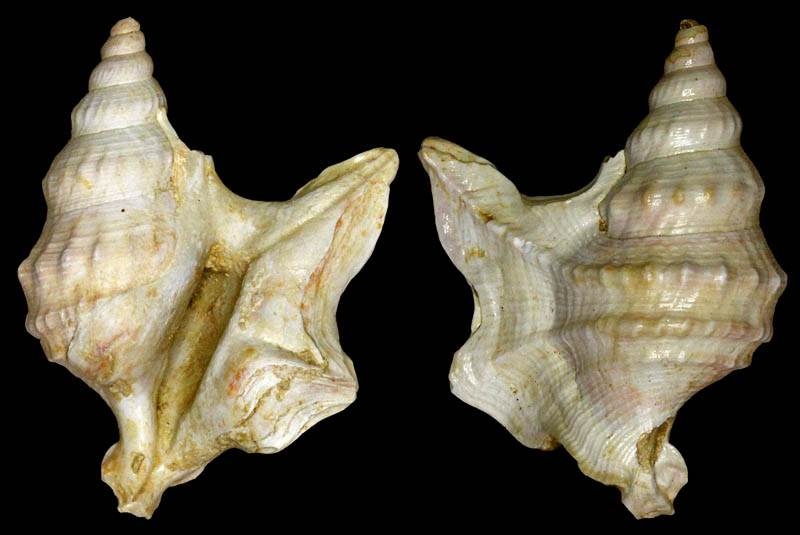|
edit SideBar
|
Species / Aporrhais Pespelecani
Stromboidea
Original Description of Strombus pes-pelecani by Linnaeus, 1758:
- "S. testae labro tetradactylo palmato digitis angulato, fauce laevi."
Synonymy
Pre-Linnean names
- ?Aporrhais Aristotle (322-384 b.C)
- Turbine pendedactylo & tessarodactylo Rondelet, 1554:92
- Pentedactylos Rondelet, 1558:60
- Tessarodactylos Rondelet, 1558:60
- Aporrhais aldrovandi Lister, 1688:pl. 866
- Pes anserinus Klein, 1753:32
Synonyms
- Aporrhais pespelecani (Linnaeus, 1758:742) [as Strombus pes pelecani]
- syn. Rostellaria ala-draconis Perry, 1811:11, fig. 6
- syn. Aporrhais aldrovandi Capellini, 1860: 55 Settepassi:1971:III [non Capellini, 1860]
- syn. Chenopus anglicus † d’Orbigny, 1852: 59
- syn. Chenopus Brusina Nalato, 1899: 5
- syn. Aporrhais conemenosi Monterosato, 1890:191 [corrected spelling for conomenosi]
- syn. Aporrhais conomenosi Monterosato, 1890:162 [incorrect original spelling]
- syn. Aporrhais conomenosi forma alterutra † Monterosato, 1890:162
- syn. Fusus fragilis † Risso, 1826:206, pl. VI, fig. 75
- syn. Murex gracilis † Brocchi, 1814:437, pl. IX, fig. 16a, b
- syn. Rostellaria michaudi Locard, 1890:11
- syn. Aporrhais pelecanipes Locard, 1892:123, fig. 109
- syn. Aporrhais pelecanipes var. incrassata Locard & Caziot, 1900:31
- syn. Aporrhais pelecanopus Locard, 1886:141
- syn. Strombus pelecani Odhner, 1953:14 [ex MS Thunberg]
- syn. Turbo pentadactylos Scilla, 1759:85 [unnumbered page]
- syn. Aporrhais pespelicani Auct. [incorrect subsequent spelling]
- syn. Aporrhais pespellicani Auct. [incorrect subsequent spelling]
- syn. Aporrhais pespelecani var. aculea Coen, 1933:pp
- syn. Aporrhais pes pelecani var. aculeus Coen, 1931:144, pl. III, fig. 10
- syn. Aporrhais pes pelecani adultus Monterosato xxxx:yy
- syn. Aporrhais pes pelecani var. adunca Coen, 1931:144, pl. III, fig. 9
- syn. Aporrhais pespelecani var. alba Jeffreys, 1859:127 Bucquoy, Dautzenberg & Dollfus, 1884: 220 [non Jeffreys, 1859]
- syn. Aporrhais pes-pelecani var. albida Jeffreys, 1867: 251
- syn. Aporrhais pes pelecani angulatus Settepassi, 1971:X, pl. 4, fig. 33
- syn. Aporrhais pes pelecani var. applicata Coen, 1931:144, pl. II, fig. 7
- syn. Aporrhais pes pelecani var. bifida Coen, 1931:144, pl. II, fig. 5
- syn. Aporrhais pes pelecani var. bilabiata Coen, 1931:145, pl. III, fig. 11
- syn. Aporrhais pes pelecani var. biloba Kobelt, 1908:15
- syn. Aporrhais pespelecani var. bilobata Clément, 1875: 51
- syn. Aporrhais pes pelecani var. brunea Settepassi, 1971: V [not available]
- syn. Aporrhais pes pelecani anom. cauda trifariam Settepassi, 1971:XI, pl. 5, fig. 36 [not available, non binom.]
- syn. Aporrhais pes pelecani var. crispa Coen, 1931:143, pl. II, fig. 3, 4
- syn. Aporrhais pes pelecani var. digitis quatuor Philippi, 1836:215 [not available, non binom.]
- syn. Aporrhais pes pelecani var. digitis quinque Philippi, 1836:215 [not available, non binom.]
- syn. Aporrhais pes pelecani var. digitis tribus Philippi, 1836:215 [not available, non binom.]
- syn. Aporrhais pes pelecani anom. digito ramosa Settepassi, 1971:XI, pl. 7, fig. 63 [not available, non binom.]
- syn. Aporrhais pes pelecani forma dilatata Settepassi, 1971:X [ex MS Monterosato] [not available]
- syn. Aporrhais pes pelecani monstr. distorta Settepassi, 1971:XII, pl. 8, fig. 64 [not available]
- syn. Aporrhais pes pelecani var. eburnea Monterosato, yyyy:pp
- syn. Aporrhais pespelecani elongatus Settepassi, 1971:XX
- syn. Aporrhais pes pelecani var. furcifera Coen, 1931:144, pl. II, fig. 6
- syn. Aporrhais pes pelecani var. gigantea Coen, 1931:145, pl. III, fig. 13, 14
- syn. Aporrhais pespelecani gracilis-expansilabrum Stjepcevic & Parenzan, 1980
- syn. Aporrhais pes pelecani var. idealis Coen, 1931:143, pl. II, fig. 2
- syn. Aporrhais pes pelecani anom. labrata Settepassi, 1971, pl. 1, fig. 7 [not available]
- syn. Aporrhais pes pelecani var. longispina Kobelt, 1908:16
- syn. Aporrhais pes-pelecani var. longispinosus Norman, 1888:13 [nom. nud.]
- syn. Aporrhais pes-pelecani var. longispinosus Kobelt, 1908:15, pl. 101, fig. 10,11
- syn. Aporrhais pes pelecani longispinulus Settepassi, 1971:VII [ex MS Monterosato]
- syn. Aporrhais pes pelecani var. longisdigitatus Settepassi, 1971:VII, pl. 2, fig. 11, 14 [ex MS Monterosato] [not available from Settepassi]
- syn. Aporrhais pespelecani major nodoso Settepassi, 1971:XX [not available, non binom.]
- syn. Aporrhais pes pelecani var. mandarinus Monterosato, year: p. / pl. Fig.
- syn. Aporrhais pes pelecani var. minor Fontannes, 1884
- syn. Aporrhais pes pelecani var. minor Monterosato, 1890: 162
- syn. Aporrhais pespelecani monodigitata Stjepcevic & Parenzan, 1980
- syn. Aporrhais pes pelecani anom. multi-digitata Settepassi, 1971:XI, pl. 7, fig. 55 [not available]
- syn. Aporrhais pes-pelecani var. obesa Bucquoy, Dautzenberg & Dollfus, 1884: 220 [obesa in text is robusta on plates]
- syn. Aporrhais pespelecani oblongus Settepassi, 1971:VII
- syn. Aporrhais pes-pelecani var. oceanica Bucquoy, Dautzenberg & Dollfus, 1884: 220, pl. 24, fig. 4, 5
- syn. Aporrhais pespelecani var. panormitanus de Gregorio, 1885:118
- syn. Aporrhais pes pelecani var. parva Settepassi, 1971:VI [ex MS Monterosato]
- syn. Aporrhais pes pelecani anom. permixtus Settepassi, 1971, pl. 13, fig. 70 [not available]
- syn. Aporrhais pes pelecani var. protracta Coen, 1931:144, pl. III, fig. 8
- syn. Aporrhais pes pelecani pseudobilobatus Settepassi, 1971:IX, pl. 2, fig. 10B, pl. 3, figs. 19, 24
- syn. Aporrhais pespelecani quadrifida Geys & Marquets, 1979:22, pl. 28, fig. 1
- syn. Aporrhais pes-pelecani var. robusta Bucquoy, Dautzenberg & Dollfus, 1884, pl. 24, fig. 3
- syn. Aporrhais pespelecani robustissimus Settepassi, 1971:XIX, fig. 81, 82
- syn. Aporrhais pes pelecani var. rufa Monterosato, 1882:pp
- syn. Aporrhais pes pelecani monstr. scalariforme Coen, 1914:31, pl. III, fig.14 [not available]
- syn. Aporrhais pes pelecani monstr. scalaris Coen, 1931:145, pl. III, fig. 12 [not available]
- syn. Aporrhais pes pelecani anom. tri-costata Settepassi, 1971:XII, pl. 8, fig. 65 [not available]
- syn. Aporrhais pes pelecani triplus digitatus Settepassi, 1971:XX, pl. 14, fig. 73, 76 [not available, non binom.]
- syn. Aporrhais pes pelecani var. venetiana Coen, 1931:142, pl. II, fig. 1
- syn. Aporrhais pespelecani var. viator de Gregorio, 1885:118
- syn. Aporrhais (Chenopus) pes pelecani var. vinitincta Coen, 1914:31, pl. III, fig. 13a, b
- syn. Aporrhais pes pelecani var. violacea Monterosato, 1884: p. / pl. Fig.
- syn. Aporrhais pespelecani var. violacea Bucquoy, Dautzenberg & Dollfus, 1882: pp [ex MS Monterosato]
- syn. Chenopus pespelicani var. apicevoluta † Sacco, 1893:31, pl. II, fig. 37
- syn. Chenopus pespelicani var. basicincta † Sacco, 1893:31, pl. II, fig. 36
- syn. Chenopus pespelicani var. crenulatina † Sacco, 1893:30, pl. II, fig. 32
- syn. Chenopus pespelicani var. dertominor † Sacco, 1893:29, pl. II, fig. 31
- syn. Chenopus pespelicani var. parvecincta † Sacco, 1893:30, pl. II, fig. 33
- syn. Chenopus pespelicani subvar. perbifida † Sacco, 1893:29, pl. II, fig. 28 [not available]
- syn. Chenopus pespelicani subvar. superbifida † Sacco, 1893:29, pl. II, fig. 29 [not available]
- syn. Chenopus pespelicani var. taurominor † Sacco, 1893:29, pl. II, fig. 30
- syn. Chenopus pespelicani var. turritolonga † Sacco, 1893:30, pl. II, fig. 34
- syn. Chenopus pespelicani var. variecincta † Sacco, 1893:30, pl. II, fig. 35
- syn. Aporrhais pespelicanis Linnaeus, 1758 Camacho, 1953:185 [incorrect subsequent spelling]
- syn. Aporrhais quadrifidus da Costa, 1778: 136, pl. VII, fig. 7
- syn. Struthiodomus struthiomorpha Coen, 1931: 145 [ex MS Monterosato]
- syn. Aporrhais subfuscus Donovan, 1804 pl. IV. Filippi, 1986: 79 [non Donovan, 1804]
- syn. Aporrhais uttingeriana Risso, 1826 Harmer, 1918:435, pl. 41, fig. 31 [non Risso, 1826]
Common names
- Danish: Pelikanfod
- Dutch: Pelikaansvoet
- English: Common pelican foot
- French: pied de pelican
- Georgian: Moluski aporaisi
- German: Pelikansfuss
- Italian: piede di pellicano
- Japanese: MOMIJISODE
- Norwegian: pelikanfotsnegl
- Russian: Pelicanya noga
- Spanish: Pie de pelicano
- Swedish: pelikanfotsnäckor
- Turkish: Pelikan ayagi
History and extended Synonymy
1554
Turbine pendedactylo & tessarodactylo in Rondelet, 1554, p. 92, fig. XXII
1558
Gesner, 1558, p. 246
Turbine pentadactylii Gesner, 1558, p. 246
1606
Aldrovandi, 1606, p. 357/358
Pentedactylos Aldrovandi, 1606, p. 357, 358
1681
Turbine pentidattilo Buonanni, 1681, Figs. 85, 87
1688
Lister presents two forms:
Only the second is cited by Linnaeus, 1758, 1767
1742
in Argenville, 1742, pl. 17, fig. M
1743
Description of Strombus canaliculatus rostratus ore labioso by Gualtieri, 1743:
Strombus canaliculatus rostratus ore labioso in Gualtieri, 1743
1753
Klein, 1753, p. 32, §81, 82
Pes anserinus in Klein, 1753, pl. II, fig. 41, 42
1758
Original description of Strombus pes pelecani by Linnaeus:
1759
Turbo pentadactylus in Scilla, 1759, pl. XVI, fig. 1
- Comment U. Wieneke: Scilla gives no description, only the above drawing with the name on p. 85 (unnumbered)
1767
Description of Strombus pes pelecani in the 12th edition of the "Systema Naturae" by Linnaeus:
1777
Alata Pes Pelicani Martini, 1777, pl. LXXXV, fig. 848-850
1778
Aporrhais quadrifidus da Costa, 1778
- Description of Aporrhais quadrifidus by Da Costa, 1778, p. 136-138:
- "Aporrhais subfuscus, anfractibus nodosis, labro palmato quadrifido. Quadrifidus."
- "This Shell is extremely thick and strong. The body is narrow, slender, and tapers to a very fine point; from top to bottom it generally measures from one inch and a half to two inches in length, and from the body to the middle of the wing, between the fingers or prongs, one inch and a quarter broad; and the colour is very pale yellowish brown. The mouth is narrow and oblong. The outer tip expands into a very thick wing, swelling to a greater thickness at the edge, which slopes slightly downwards, and is sinuous or waved. It is cut or divided into four singers or prongs, whereof two are in the middle: the upper of these is nearly horizontal, or slightly ascending, the other very obliquely descending. The remaining two, which are on the body, are both very perpendicular; the upper one, directly on the top of the mouth, forms a pretty long waved pyramidal sharp beak; the other, that runs downwards along the body to almost the end of the turban, is very valid, spread, and sharp pointed. These two latter prongs should more properly be said to belong to the pillar than the outer lip. The interrstices between the prongs are cut into deep semilunar cuts or scollopings and each prong on this side has a channel along the middle. The pillar lip is very thick, strong, and spread; and all the mouth, wing, and pillar, within, are white, smooth, and finely glazed, except towards the ends of the prongs, which are tinctured with shades of a chesnut colour.The spires are about eight, tapering to a very fine point, and separated by a deep slope and furrow. Each spire has a prominent ridge, studded or bumped with round knobs, size of a pin's head, that runs circular along the middle of it. From this ridge it slopes upwards and downwards. But the body spire has two ridges, the lowermost whereof is greatly knobbed, and extends (but then plain, very sharp, prominent and oblique) to the border of the wing, exactly to the descending prong, and answers to its gutter on the inside; the upper ridge is not so bumped, and continues also sharp, ascending along the wing, and answers to the inside gutter of the ascending prong. Besides, there is a third slightly prominent plain ridge just above the latter, which also continues on the wing, but slightly, and does not reach to the edge of it. The spires, and also the wing, are besides finely and circularly striated."
- Localities (Da Costa, 1778, p. 138): "This species is found in Cornwall, Devonshire, Durham, Sussex, and some other shores; in Carnarvonshire and Merionethshire, Wales; and is common in the Orkneys, at Leith, and several other coasts of Scotland. It inhabits also die Norwegian, Mediterranean, and American seas. "
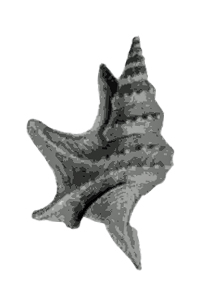 Aporrhais quadrifidus da Costa, 1778, pl. VII, fig. 7
1789
Tritonium pes pelecani Müller, 1789, pl. 87, figs. 1, 2
1811
Rostellaria pes-pelicani in Perry, 1811, pl. 10, Rostellaria fig. 3
Rostellaria ala-draconis Perry, 1811, pl. 11, fig. 6
- Comment Petit, 2003: "The unusual blue coloration is possibly the result of burial in mud."
1814
Murex gracilis Brocchi, 1814:
- Description of Murex gracilis by Brocchi, 1814, p.437:
- "Testa turrita, exquisite transversim striata, anfractubus convexiusculis subcarinatis, carina nodulosa, anfractu infimo ad basim cingulo elevato succincto, labro fisso."
- "Tutti gli anfratti sono rigati all'intorno da sottilissime strie regolari e paralelle, ed hanno una forma alquanto gonfia e convessa. L'ultimo di essi è circondato nella parte iuferiore da un cingolo elevato, e tutti hanno verso la loro metà una carena molto ottusa, guarnita di una serie di piccioli nodi bislunghi I cinque anfratti superiori sono lisci, e non hanno che le strie trasversali."
- "Fossile nel Piacentino" Brocchi, 1814, p. 437
Murex gracilis Brocchi, 1814, pl. IX, fig. 16 a, b
- Comment: is a Pliocene, juvenile Aporrhais pespelecani
1817
Rostellaire pied de pélican (Rostellaria pes pelicani, Lamk.) from Cuvier, 1817, pl. 61bis 3a,3,3b
1826
Fusus fragilis Risso, 1826
- Description of Fusus fragilis by Risso, 1826, p. 206:
- "F. Testa glaberrima, alte et acutissime turrita; anfractubus duodecim (apicali mamillato), linea elevata, lineolisque elevatis longiludinalibus, lineisque transversis, undulatis sculptis; epidermide lutescente."
- "Cette belle coquille fort lisse, est fragile, turriculée en pointe, d'un jaune transparent; à douze tours de spire (celui du sommet mamelonné) sculptés d'une ligne relevée et de petites lignes élevées longitudinales, accompagnées de lignes ondulées, transverses. Long. o,o35 Séj. Régions coralligènes. App. Été."
Fusus fragilis Risso, 1826, pl. VI, fig. 75
- Comment: is a juvenile Aporrhais pespelecani.
1834
Rostellaria pes-pelicani Joannis, 1834, cl. V, pl. 41
Texte about Rostellaria pes-pelicani of Joannis, 1834:
- ”Animal inconnu, d’après M. de Blainville. Tête sessile terminée en forme de museau, peu contractile, à l’extrémité duquel est une bouche ronde à lèvres simples, sans trompe, portant, en outre, deux tentacules longs, assez grêles, coniques, peu contractiles et assez éloignés, au pied externe desquels sont des yeux très visibles sur un öéger renflement qu’ils y ont. Pied assez grand, pédonculé, sous-oesophagien, comme tronqué devant et pointu derrière, où s’attache en dessus un petit opercule onguiculé, à sommet submarginal, n’adhérant au pied que par sa moitié. Manteau très mince, lacinié en autant de parties que le bprd droit de la coquille a de digitations. Les deux laciniures extrèmes formant des tubes. Peignes branchiaux, longs, étroits, et l’un auprès de l’autre, situés un peu obliquement sur le dos. Organe excitateur long, aplati, placé au côté droit du cou. L’anus dans et à l’entrée de la bouche une espèce de ganglion bilobé adhérant à la paroi inférieure, et sur l’arrière de cette partie une petite langue hérisée des deux côtés de petites aspérités couchées les unes sur les autres en arrière. (…) La tète, le pied et la partie antérieure ddu corps sont rouge et jaune pàle pointillé, les branchies blanches, l’organe excitateur blanc. Le reste du corps varie avec les aliments. Le bord des lèvres est blanc, et cette bordure blanche remonte en pointe sur le museau. Nota. Je pense que le tube gauche du manteau, qui correspond à la digitation postérieure de la coquille, donne passage à l’organe mâle. Patrie, l’Archipel du Levant."
1837
Chenopus pes pelecani in Bronn, 1837, pl. XLI, fig. 30
1842
Aporrhais Pes-Pelecani in Sowerby, 1842, pl. V, fig. 3, 4
Aporrhais pes pelecani in Gray, 1842, pl. 5, fig. 6
1843
Rostellaire pied-de-Pelican. (Rostellaria pes Pelecani Lam.) in Kiener, 1843, pl. IV, fig. 1
Rostellaire pie-de-Pelican jeune. (Rostellaria pes Pelecani junior.) in Kiener, 1843, pl. IV, fig. 1a
- Comment Wieneke: "This is not a juvenile specimen, it looks more like A. p. bilobata."
1847
Strombus pes pelecani in Berge, 1847, pl. ?, fig. 9
1848
Aporrhais pespelicani in Wood, 1848, pl. II, fig. 4 a, b
Wood, 1848, p. 25 about Aporrhais pes-pelicani:
- "Locality. Cor. Crag, Ramsholt and Gedgrave. Red Crag, Sutton, Newborn, Brightwell, and Bawdsey. Recent, British Seas."
- "This shell is rarely found in good condition in the Red Crag; some well-preserved specimens, however, show a perfect identity with the long known recent species. The middle of the volution is slightly angular and nodulous, so also is the prominent keel at the base of the whorl, like that of the recent shell, with another ridge beneath it. The striae are obliterated from all my Red Crag specimens, though shown in those from the Coralline. This is a living Mediterranean species, and stated by Philippi to be exceedingly variable there. My Crag specimens are very uniform in character."
- Wieneke: see Chenopus anglicus
1851
Rostellaria pes-pelecani in Reeve, 1851, Rostellaria, pl. 1, fig. 3 a, b
1853
Aporrhais pes-pelecani in Forbes & Hanley, 1853, pl. LI, fig. 3, 3a
Aporrhais pes-pelecani in Forbes & Hanley, 1853, pl. LXXXIX, fig. 4
Chenopus pespelecani Hoernes, 1853, pl. 18, fig. 2 a, b
- This shell is classified by Sacco as Chenopus uttingerianus var. crassulosa Sacco, 1893. see Aporrhais uttingeriana
Hörnes, 1853, p. 193:
- "Fundorte: Baden (Fig. 3, 4), Vöslau, Möllersdorf, Gumpoldskirchen, Gainfahren (Fig. 2), Enzesfeld, Grinzing, Steinabrunn, Nikolsburg (Muschelberg, Kienberg), Malomeritz bei Brünn, Grund, Forchtenau, Ritzing, Kralowa, Szobb bei Gran in Ungarn (häufig)."
- "Die ungemeine Veränderlichkeit dieser Art in Betreff ihrer Formen hat mehrere Autoren, wie wir aus dem Literatur-Verzeichniss ersehen, veranlasst, dieselbe in mehrere Arten aufzulösen, allein aus einem genauen Studium einer grossen Anzahl hierher gehöriger Formen, wie sie mir aus der kaiserlichen Sammlung vorliegen, entnehme ich, dass alle durch auffallende Eigenschaften als Typen einzelner Arten hingestellten Formen durch Mittelglieder derart verbunden sind, dass man am Ende nicht weiss, ob man das vorliegende Exemplar zu einer oder zur anderen Art zählen soll. Diess ist stetst der sicherste Beweis von dem Zusammengehören der betreffenden Formen. Nach dieser Untersuchung halte ich die Rostellaria pes carbonis eben so wie den Chenopus pes graculi für Extreme unserer Species, eine Ansicht, welche übrigens schon Pusch ausgesprochen hat und welcher Nyst beipflichtet."
- "Die Schale ist spindelförmig. Das Gewinde ist spitz und besteht aus sieben bis acht gekielten Windungen, die auf den Kielen eng stehende Längsknoten tragen. Der letzte Umgang ist mit einem dreifachen Kiel versehen, von denen jedoch meist nur der obere und zum Theil der zweite deutliche Längsknoten tragen, während der unterste glatt erscheint; die ganze Schale ist übrigens mit Querstreifen bedeckt. Die Mündung ist schief und eng. Der rechte Mundrand erweitert sich in einen in dreispitzige Zacken getheilten Lappen, welche Zacken nach den Varietäten bald länger bald kürzer und auf ihrer inneren Seite mit einer Furche versehen sind. Der linke Mundrand ist schwielig und verlängert sich nach unten in einen mehr oder weniger langen, gekrümmten oder geraden Halbcanal. Chenopus pelecani ist eine der verbreitetsten Conchylien in den neogenen Schichten; sie ist für dieselben eine wahre Leitmuschel, und die gleiche Verbreitung dieser Art sowohl in den miocenen als pliocenen Schichten spricht abermals für eine Vereinigung dieser Ablagerungen. Brongniart führt diese Art aus den eocenen Schichten von Roncà an, doch sollte es vielleicht Turin heissen, da mir diese Art noch nie aus den Schichten von Roncà zu Gesichte gekommen ist, obgleich das kaiserliche Cabinet eine reiche Suite von dieser Localität besitzt.Dieses vorausgesendet kommt der Chenopus pes pelecani meist, nach Exemplaren, welche sich im kaiserlichen Cabinete befinden, an folgenden Orten vor: In der Touraine, zu Bordeaux (Leognan) und Dax (St. Paul), zu Frejus, Carry, Sausset, Istres im südöstlichen Frankreich, bei Turin, Asti, Nizza, Castell'nuovo, Andona, Castell'arquato, Siena, Carrubbare bei Reggio, Ischia und Pozzuoli bei Neapel, und zu Nizzeti, Cefali, Girgenti, Villasmonde, Caltanisetta, Caltagirone, Sciacca, Militello, Palermo und im vulcanischen Tuff am Aetna über der Bai von Trezza in Sicilien. In dem Tertiär Becken von Lissabon, auf der Halbinsel Morea und auf den Inseln Cypern und Rhodus, zu Korod und Lapugy in Siebenbürgen, Nemesey im Banate, Tarnopol in Galizien, zu Zuckowce und Bialozurka in Volhynien, zu Tarnaruda in Podolien, zu Korytnice und Pinczow in Polen, zu Flohnheim bei Alzey im Mainzer-Becken, zu Antwerpen, Lillo und Calloo in Belgien, zu Ramsholt und Gedgrave in England und zu Christiania in Norwegen. Auch lebend kommt diese Species häufig nicht nur im mittelländischen Meere, an den Küsten von Sicilien u.s.w., sondern auch in der Nord- und Ostsee vor, und gehört zu den gemeinsten Vorkommnissen in den europäischen Meeren, daher ihr häufiges Vorkommen in den neogenen Schichten zur Erklärung der Erscheinung dieser Ablagerungen besonders wichtig. Im Wienerbecken ist diese Art sehr gemein und kommt an den oben bezeichneten Fundorten sehr häufig vor, namentlich in dem Tegel von Baden und Vöslau. Sammlung des k.k. Hof-Mineralien-Cabinetes und der k.k. geologischen Reichsanstalt."
- Comment Wieneke: Hörnes lumps all Aporrhais sp. beginning with the oligocene ones into Aporrhais pespelecani. This is also reflected in his synonymy.
1859
Aporrhais pes-pelicani from Sowerby, 1859, pl. XV, fig. 4
- Comment: Sowerby is showing the Mediterreanian subspecies as coming from the British Isles. Whether the specimen is coming from the North Atlantic / North Sea or from the Mediterranian is not known.
1860
Aporrhais aldrovandi Capellini, 1860
1863
Aporrhais pes pelecani, radula Troschel, 1863, pl. XVII, fig. 3 ("Ein Glied aus der Radula von Aporrhais pes pelecani L.")
- Description of the radula of Aporrhais pespelecani by Troschel, 1863, p. 200:
- "Jeder Oberkiefer bildet einen gebogenen Streifen von ungefähr 0,4 Millim. Länge bei einer Breite von 0,01 Millim. Er ist mit zahlreichen kleinen Plättchen bedeckt, die sich meist nicht dachziegelartig decken, sondern eng neben einander liegen. Sie haben eine rautenförmige oder polygonale Gestalt und einen Durchmesser von 0,004 bis 0,007 Millim. Die Mittelplatten der Radula sind vorn, wo sich die Schneide umgekrempt, am breitesten, verschmälern sich von da nach hinten bis etwa zur Mitte, um dann bis zum abgestutzten Hinterrande fast gleich breit zu bleiben. Die Schneide trägt einen grösseren, aber durchaus ganzrandigen Mittelzahn und jederseits neben ihm drei bis sechs kleinere Zähnchen, die nach dem Vorderende der Radula meist ganz abgenutzt sind, so daß die Platten hier fast ganzrandig, nur mit einem stumpfen Mittelzahn versehen erscheinen. Wie schon oben bemerkt, kann ich von der seltsamen Zähnelung des Mittelzahnes bei Lovén nichts wahrnehmen, wogegen seine Umrisse der Mittelplatte der Naturwahrheit näher kommen, als die nach hinten viel zu sehr verschmälerte Darstellung von Woodward. Die Zwischenplatten bilden ein längliches Oval, das sich einem Dreieck nähert. Der Vorderrand krempt sich der ganzen Länge nach zu einer ganzrandigen Schneide um, die mit der inneren Spitze zahnartig vorspringt. Der Innenrand schweift sich unter jener Spitze nach innen und geht dann in einem großen Bogen in den Hinterrand über, der so zart ist, daß es eines glücklichen Bloßlegens der Platte bedarf, um ihn scharf verfolgen zu können. Die Seitenplatten sind sehr lange schmale, säbelförmig gebogene Dornen, ohne jede Zähnelung. Sie sind so lang, daß sie in eingeklappter Lage bis über die Mittelplatte hinaus reichen, sich also mit den Seitenplatten der anderen Seite kreuzen. Die innere und die äußere Seitenplatte sind gleich lang, da jedoch die äußere etwas weiter nach außen befestigt ist, so steht auch ihre Spitze gegen die der inneren ein wenig zurück. Die Radula enthält 32-34 Glieder. Die Breite der Mittelplatten am Vorderende der Radula ist vorn 0,085 Millim., hinten 0,045 Millim.; am Hinterende der Radula vorn 0,09 Millim., hinten 0,057 Millim."
1867
Aporrhais pespelecani var. albida Jeffreys, 1867
1875
Clement, 1875,p. 10:
- "No. 39. - APORRHAIS PIED DE PÉLICAN. APORRHAIS PES PELECANI (Lamk).
- Rostellaria. Lamk., t. IX, p. 656. Payr, p. 152. Sow. pl. 15, f. 4.
- Hab. Golfe d'Aiguesmortes, fonds sablonneux de la zone des Laminaires, très-commun. Il existe une variété constante de cette espèce qui n'a pas de digitations, mais seulement deux lobes ´bilobata´. Sa couleur est d'un fauve un peu grisâtre; elle e été figurée par Martini et Chemnitz, pl. 85, f. 848. Nous le répétons, c'est une variété bien constante et qu'on pourrait même admettre au rang d'espèce- Elle a toujour la taille d'un adulte du type, et ne peut, par conséquent, être regardée comme un jeune individu."
1880
Chenopus pes-pelecani in Fontannes, 1880, pl. IX, fig. 3 a, b
- "Les marnes à Cerithium vulgatum des environs de Bolléne, de Vaison (Vaucluse). Commun. — Les argiles sableuses de Millas et de Banyuls (Pyrénées-Orientales). Très commun." (Fontannes, 1880)
1884
- Aporrhais pespelecani var. oceanica Bucquoy, Dautzenberg & Dollfus, 1884
- Aporrhais pespelecani var. robusta Bucquoy, Dautzenberg & Dollfus, 1884
- Aporrhais pespelecani var. rufa Bucquoy, Dautzenberg & Dollfus, 1884 ex Monterosato ms.
- Aporrhais pespelecani var. violacea Bucquoy, Dautzenberg & Dollfus, 1884 ex Monterosato ms.
Bucquoy, Dautzenberg & Dollfus, 1884, p. 218:
- "Obs. - Dans le jeune âge, l'Ap. pes-pelecani est dépourvu de digitations et a l'aspect d'un Fusus ou d'un Pleurotoma (Voy. pl. XXIV, fig. 9). Risso l'a dècrit et figuré en cet état sous le nom de Fusus fragilis. A un peu plus avancé le péristome a la forme d'une sorte de trapèze dont la columelle serait la base (Voy. pl. XXIV, fig. 6, 7, 8)."
- "Diagnose. — Coquille, haut. 53 millim., larg. 45 millim. (jusqu'à l'extrémité des digitations du labre), solide, à spire élevée, turriculée et acuminée. Tours convexes, subanguleux à leur partie médiane, où ils sont munis d'une rangée de plis longitudinaux arqués et tuberculeux. Ces plis sont nombreux et serrés sur les tours supérieurs; ils s'espacent graduellement sur les suivants et se transforment sur le dernier en une série de tubercules arrondis. Une série de petits tubercules peu apparents, en nombre à peu près double de celui des plis, règne à la partie inférieure des tours, immédiatement au-dessus de la suture et se prolonge sur le dernier tour en un rang de tubercules moins saillants que ceux du rang supérieur. Enfin, l'on observe encore sur le dernier tour, au-dessous des deux rangs de tubercules, un cordon décurrent faiblement tuberculeux. Toute la surface de la coquille est traversée par des stries décurrentes nombreuses, irrégulières et très fines. Ouverture allongée, se terminant à sa base en un angle très aigu. Columelle droite, dirigée obliquement. Bord columellaire calleux, appliqué et étendu à sa partie supérieure, formant ensuite un bourrelet arrondi vers le milieu du dernier tour et se prolongeant à sa base en une expansion anguleuse, foliacée. Labre très dilaté, divisé en quatre digitations divergentes, longues, pointues et palmées, creusées d'un sillon à la face interne, et pourvues à la face externe d'une crête médiane. La digitation supérieure est en partie reliée à la spire par une expansion latérale. Des deux digitations suivantes, la supérieure est la plus longue, puis il existe entre la troisième digitation et celle de la base une légère pointe qui constitue le rudiment d'une autre digitation. Le labre offre à sa base une expansion foliacée anguleuse, équivalente à celle de la base du bord columellaire, et leur réunion détermine la quatrième digitation. Le labre est émaillé, souvent très calleux à l'intérieur; les callosités paraissent lisses; mais sous un grossissement un peu fort, on remarque qu'elles sont finement chagrinées. Coloration fauve, diversement variée de blanc et de fauve plus foncé; l'extérieur du labre et la base externe de la columelle sont d'un blanc jaunâtre; les callosités de l'ouverture sont blanches. Opercule corné, lamelleUx, onguiculé."
- "Variétés. — Philippi a établi six variétés de cette espèce, d'après le nombre et la forme des digitations; mais l'Ap. pes-pelecani est si variable sous ce rapport que l'on pourrait facilement établir encore plusieurs autres variétés. Nous nous bornons à signaler ici quelques formes qui nous paraissent offrir une certaine constance. Var. ex forma 1, bilobata Clément (= ? var. meridionalis Basterot). Forme trapue, à labre très épais et formant une masse trapézoïde très calleuse. C'est la forme qui se rencontre ordinairement sur les côtes océaniques de France; nous l'avons représentée pi. XXIV, fig. 4 et 5, d'après des exemplaires qui nous ont été envoyés de l'ile de Ré par M. Lemarié. Nous avons pourtant vu dans la collection de M. le Dr Daniel des échantillons de la forme typique recueillis par lui dans la rade de Brest, C'est par erreur que cette variété se trouve nommée oceanica B. D. D. sur notre pl. XXIV. Var. ex forma 2, obesa B. D. D. A dernier tour très renflé, digitations latérales du labre bien développées et digitation basale courte. Nous établissons cette variété d'après un exemplaire qui nous a été envoyé de Cette par M. Granger, et que nous figurons pl. XXIV, fig. 3. Var. ex forma 3, minor Fontannes, représentée pl. XXV, fig. 14. Var. ex colore 1, alba Jeffreys. Entièrement blanche (Additional gleaning on British Conchology, Dublin — Mag. of Nat. Hist., p. 42, septembre 1859). Var. ex colore 2, rufa Monterosato. Var. ex colore 3, violacea Monterosato. On connaît un grand nombre de monstruosités de cette espèce."
- "Habitat. — Zones des laminaires et coralligène. Très abondant sur les plages sablonneuses, surtout à Leucate."
- "Dispersion. — Toute la Méditerranée, l'Adriatique et l'Océan, depuis les côtes de Norwège jusqu'au détroit de Gibraltar."
- "Origine. — Cette espèce semble descendre de la forme oligocène décrite sous le nom d'Ap. speciosa Schlot. Elle est abondamment répandue dans le miocène de l'Europe Centrale, dans le pliocène du Nord et du Midi (Roussillon, Companyo), et dans le pleistocène du bassin méditerranéen. On rencontre dans ces divers étages la même variabilité que dans la forme actuelle."
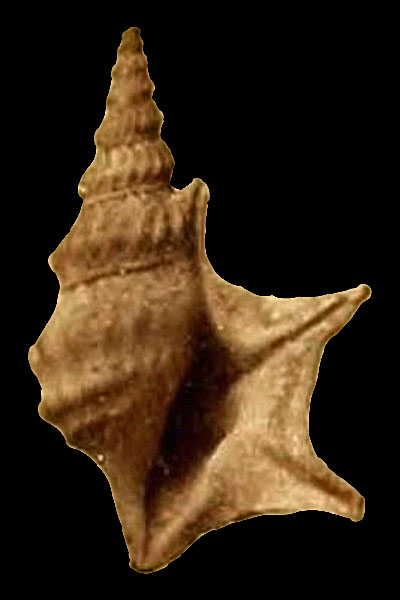 Aporrhais pes-pelecani var. minor in Bucquoy, Dautzenberg & Dollfus, 1884, pl. 23, fig. 11
Aporrhais pes-pelecani in Bucquoy, Dautzenberg & Dollfus, 1884, pl. 24, fig. 1, 2
Aporrhais pes-pelecani var. robusta in Bucquoy, Dautzenberg & Dollfus, 1884, pl. 24, fig. 3
Aporrhais pes-pelecani var. oceanica in Bucquoy, Dautzenberg & Dollfus, 1884, pl. 24, fig. 4, 5
Aporrhais pes-pelecani var. albida Jeffreys in Bucquoy, Dautzenberg & Dollfus, 1884, pl. 24, fig. 6
Aporrhais pes-pelecani juvenis in Bucquoy, Dautzenberg & Dollfus, 1884, pl. 24, fig. 7, 8, 9
Chenopus (Aporrhais) pespelecani in Hoernes & Auinger, 1884, pl. 18, fig. 7 a,b
- This shell was classified by Sacco, 1893 as Chenopus uttingerianus var. ornatissima Sacco, 1893, see Aporrhais uttingeriana
Chenopus (Aporrhais) pes pelecani in Hörnes & Auinger, 1884, pl. 19, fig. 9 a, b
- This shell was classified by Boettger, 1902 as Chenopus pespelecani var. dactylifera Boettger, 1902, see Aporrhais dactylifera
1885
Aporrhais pespelecani var. panormitanus de Gregorio, 1885:118
- Original Description of Aporrhais pespelecani var. panormitanus by De Gregorio, 1885, p. 118:
- "... l'una (Var. panormitanus) che ha il rostro anteriore contorto affato verso l'apertura, sicchè fa quasi un angolo retto con essa, e proviene dai mari di Palermo; ..."
Aporrhais pespelecani var. viator de Gregorio, 1885:118
- Original Description of Aporrhais pespelecani var. viator by De Gregorio, 1885, p. 118:
- "... l'altra (var. viator) molto simile alla specie tipo figurata in Boucquoy e Dautzenberg (tav. 24, f. 1-2 Mol. Rous.), ma col rostro anteriore più breve e contorto verso l'apertura (non tanto però quanto la varieta viator), col labbro esterno assai spesso e foliaceo, i tuberculi dei giri più grossi."
- Antonio De Gregorio, 1885. Studi su talune conchiglie Mediterranee viventi e fossili
Aporrhais pes-pelecani in Lorie 1885 pl.5, fig. 15
- Utrecht, The Netherlands in 369 m depth
1886
1890
- Aporrhais conemenosi Monterosato, 1890
- Original Description of Aporrhais conomenosi [sic] by Monterosato, 1890, p. 162:
- "A.Conomenosi, Monts. - Nuova forma nana (rabougrie) che mi è stata recentemente communicata dal solerte signor N. Conemenos come proveniente dall'Arcipelago Greco. Il piu piccolo esemplare, essend completamente adulto, anzi vecchio, non attinge i 17 mill. di altezza ed il piu grande non sorpassa i 30. I lobi sono corti e rintuzzati e le nodulosità molto spiccate. Siamo debitori di una figura consimile, in piu grandi proporzioni, proveniente dall'isola di Milo (Ann. Mus. Civico di Genova 1878, p.20, f. 2, nel testo) e di altre utili cognizioni, al Prof. A. Issel. Negli stessi Annali 1877, io ho pubblicato un articolo che tratta delle mutazioni e dello stato giovanile dall' A. pespelecani. Questa nuova forma, che puo realmente considerarsi come specifica, si trova anche fossile nel pliocene di Altavilla presso Palermo. La forma fossile di Monte Pellegrino, non è nè l'una nè l'altra e potra distinguersi col nome di: alterutra.
- Aporrhais michaudi Locard, 1890
Rothpletz & Simonelli, 1890, p. 714:
- "61. Chenopus cf. pes-pelecani (L.).
- Murex gracilis Brocchi, .lc., t. II, p. 437 u. 664, t. IX, f. 16, 1814.
- Von La Vista [Gran Canaria] liegt mir nur ein unvollständiges Exemplar vor."
- Comment: probably Lower Pliocene
1892
Aporrhais pelecanipes Locard, 1892
1893
Sacco, 1893 defined
Chenopus pespelicani var. apicevoluta † Sacco, 1893:31, pl. II, fig. 37
- Original Description of Chenopus pespelicani var. apicevoluta by Sacco, 1893, p. 31:
- "Labii digitus superus apicem versus elongatior, testae propinquior."
- Stratum typicum: "Astiano"
- Locus typicus: "Astigiana (non rara)"
Chenopus pespelicani var. apicevoluta Sacco, 1893, pl. II, fig. 37
Chenopus pespelicani var. basicincta † Sacco 1893:31, pl. II, fig. 36
- Original Description of Chenopus pespelicani var. basicincta by Sacco, 1893, p. 31:
- "Sub tertio cingulo, basali, cingulellum simplex conspicitur."
- Stratum typicum: "Piacenziano superiore"
- Locus typicus: "Volpedo (rara)"
Chenopus pespelicani var. basicincta Sacco, 1893, pl. II, fig. 36
Chenopus pespelicani var. crenulatina † Sacco 1893:30, pl. II, fig. 32
- Original Description of Chenopus pespelicani var. crenulatina by Sacco, 1893, p. 30:
- "Testa plerumque minor. Labium externum intus parvule crenulato-denticulatum."
- Strata: "Piacenziano, Astiano"
- Loci: "Piacenziano: Astigiana, Volpedo; Masserano; R. Torsero, Bordighera, Bussana (freq.). Astiano: Astigiana (non rara)."
- Comment: "Il carattere del labbro denticulato non ha, a mio parere quell'importanza, su diverse forme di C. pespelicani specialmente nella parte inderiore del labbro; la varieta in esame collegasi insensibilmente colle var. minor e parvecincta. D'altronde tali denticolazioni labiali riscontransi pure nel gruppo del C. uttingerianus, cosi nella var. miodenticulata. Fra le forme viventi il C. senegalensis Gray presenta tale carattere assai accentuato."
- Translation of the comment by Forli, 1989, p. 53: "The feature of the denticled lip does not, in my opinion, have as much importance as would appear at first sight, since it can be seen, even if only slightly, on several forms of C. pespelecani, especially in the lower part of the lip; the variety under examination is connected to the var. minor e parvecincta. Besides such labial denticulation is also to be found in the group of C. uttingerianus as also in the variety miodenticulata. Among living forms C. senegalensis Gray presents these features in a very marked manner."
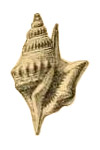 Chenopus pespelicani var. crenulatina Sacco, 1893, pl. II, fig. 32
Chenopus pespelicani var. dertominor † Sacco 1893:29, pl. II, fig. 31
Chenopus pespelicani var. dertominor Sacco, 1893, pl. II, fig. 31
Chenopus pespelicani var. parvecincta † Sacco 1893:30, pl. II, fig. 33
Chenopus pespelicani var. parvecincta Sacco, 1893, pl. II, fig. 33
....
Chenopus pespelicani subvar. perbifida † Sacco 1893:29, pl. II, fig. 28
Original Description of Aporrhais pespelicani subvar. perbifida by Sacco, 1893, p. 29:
- "Cingulum medium in regione labiali bifidum. Piacenziano: Masserano (rara)."
Chenopus pespelicani subvar. perbifida Sacco 1893, pl. II, fig. 28
Chenopus pespelicani subvar. perbifida Sacco 1893; Holotype; Coll. Museum Turin no. BS 041.01.016
....
Chenopus pespelicani subvar. superbifida Sacco 1893:29, pl. II, fig. 29
Original Description of Aporrhais pespelicani subvar. superbifida by Sacco, 1893, p. 29:
- "Cingulum superum in regione labiali bifidum. Astiano inferiore: Rocca d'Arazzo (rara)."
Chenopus pespelicani subvar. superbifida Sacco 1893, pl. II, fig. 29
Chenopus pespelicani subvar. superbifida Sacco 1893; Holotype; Coll. Museum Turin no. BS 041.01.017
....
Chenopus pespelicani var. taurominor † Sacco 1893:29, pl. II, fig. 30
Original Description of Chenopus pespelicani var. taurominor by Sacco, 1893, p. 29:
- "Testa minor, gracilior. Granulationes plerumque minus perspicuae, in longitudinem magis pliciformes. Labium interdum subalatum."
- Elveziano: Baldissero (frequente), Colli Torinesi, Turin, Metropolitan City, Piedmont Region, Italy
Comment Sacco, 1893, p.29:
- "Osservazioni. - Passa gradualmente alle var. minor e dertominor. Le è affine la var. burdigalensis (D'Orb.), distinta però specialmente per mole maggiore; ma queste diverse forme sono tanto variabili che se esse nel complesso hanno una facies speciale, ad un esame analitico non presentano alcun carattere proprio immutabile; talora il labbro si presenta assai espanso per modo da ricordare la var. anglica e simili. Ricorda alquanto il C. gracilis Meyer dell'Eocene dell'Alabama."
Sacco, 1893 cited
- 1867. Chenopus pespelicani L. - Mayer. Cat. foss. tert. Mus. Zürich, I, pag. 11.
Chenopus pespelicani var. taurominor Sacco 1893, pl. II, fig. 30 a, b
Chenopus pespelicani var. taurominor Sacco 1893; Holotype; Coll. Museum Turin no. BS 041.01.018
....
Chenopus pespelicani var. turritolonga † Sacco 1893:30, pl. II, fig. 34
Original Description of Chenopus pespelicani var. turritolonga by Sacco, 1893, p. 30:
- "Testa elongatior, turritor, aliquantulum gracilior. Astiano: Astigiana (non rara)"
Chenopus pespelicani var. turritolonga Sacco 1893, pl. II, fig. 34
Chenopus pespelicani var. turritolonga Sacco 1893; Holotype; Coll. Museum Turin no. BS 041.01.023
.....
- Chenopus pespelicani var. variecincta † Sacco 1893:30, pl. II, fig. 35
1900
Aporrhais pelecanipes Locard, 1900, p. 38, fig. 16
Aporrhais pespelecani var. incrassata Locard & Caziot, 1900
1904
Chenopus pespelicani in Cossmann, 1904, pl. IV, fig. 3
1906
Aporrhais pes-pelecani in Kobelt, 1906, pl. CI, fig. 10, 11
Aporrhais pes-pelecani bilobatus in Kobelt, 1906, pl. CI, fig. 12, 13
Aporrhais pes-pelecani michaudi in Kobelt, 1906, pl. CI, fig. 14, 15
1908
Aporrhais pes pelecani sarsii Kobelt, 1908: 17, pl. 102, fig. 3, 4
1913
Aporrhais pes-pelecani in Dautzenberg, 1913, pl. 16, fig. 52
1914
- Aporrhais pespelecani var. vinitincta Coen, 1914
1931
Description of Aporrhais pespelecani var. venetiana by Coen, 1931, p. 142:
- "I. - Var. venetiana. È la forma comune a Venezia, dove è edule e considerata come ghiottornia sotto il nome vernacolo di «zamarùgola». Digitazioni larghe, spesse, più brevi che nel tipo; la terza è biloba; tutta la conchiglia è pesante, grossolana; la callosità labiale è molto grossa, la quarta digitazione breve, contorta."
Aporrhais pespelecani var. venetiana Coen, 1931, pl. II, fig. 1
Aporrhais pespelecani var. idealis Coen, 1931, pl. II, fig. 2
- Aporrhais pespelecani var. bifida Coen, 1931
- Aporrhais pespelecani var. aculeus Coen, 1931
1970
- Aporrhais pespelecani oblongus Settepassi, 1970
- Aporrhais pespelecani robustissimus Settepassi, 1970
1984
Aporrhais pespelecani radula in Bandel, 1984, p. 67, fig. 99
2007
Aporrhais pespelecani in Bandel, 2007, pl. 1, fig. 13-16
- Fig. 13: Ornament of the larval whorl of Aporrhais pespelicani is smooth with very fine granules.
- Fig. 14: The transition of larval shell to teleoconch in Aporrhais pespelicani is not distinct and teleoconch ornament enters below the final larval whorl, with 1 mm high and 0.8 mm wide shell.
- Fig. 15: Aporrhais pespelicani shortly after metamorphosis with first teleoconch added and almost 2 mm high shell.
- Fig. 16: Embryonic shell of Aporrhais pespelicani is rounded and about 0.2 mm wide, set off from the larval shell by growth lines.
2008
Kantor et al, 2008 report large populations of Aporrhais pespelecani from the Barents sea on the Murman coast. Exact localities are:
- Kislaya Guba (Inlet) of the Motovsk Bay (69°31.6’N; 33°15.4’Е), July 2007, at muddy sand at 8 m in the biocenose of the bivalves Mytilus edulis and Arctica islandica.
- Dalnezelenezkaya Bay (69°07’03’’N; 36°04’12’’Е), August 2007, at muddy sand at 6 m.
2013
Snigirov et al., 2013:
- "...the first finding of two gastropod species, Aporrhais pespelecani and Turritella communis in the north-western part of the Black Sea more than 500 km north from the edge of their native range (the Bosphorus Strait)."
There are 2 recent subspecies, named:
- Aporrhais pespelecani pespelecani (Linnaeus, 1758)
- Aporrhais pespelecani bilobatus (Clement,1875)
- Clément, 1875; Cat. moll. Gard, p. 10
Aporrhais pespelecani (Linnaeus, 1758); from southern Europe
Aporrhais pespelecani pespelecani (Linnaeus, 1758)
- Gammarth, Tunis Governorate, Tunesia; beached, 1992; Coll. UW954
- Torrevieja, Alicante Province, Valencian Autonomous community, Spain; by fisherman, 7/1973; Coll. UW1767
- Fiumicino, Metropolitan City of Rome, Lazio Region, Italy; 80-200 m sandy bottom, by fisherman, 2000; Coll. UW1973
- South Portugal; by fisherman, 50-80 m, 2005; Coll. UW1946
- Lisbon, Lisbon Region, Portugal; 1989; Coll. UW1614
- Adra, Almeria Province, Autonomous community of Andalusia, Spain; beached, 1/1993 Coll. UW999
- Fiumicino, Metropolitan City of Rome, Lazio Region, Italy; 80-200 m sandy bottom, by fisherman, 2000; Coll. UW1975
- Ventimiglia, Imperia Province, Liguria Region, Italy; by diver, 7/1980: Coll. UW577
- Sicily Island, Sicily Region, Italy; 1993; Coll. UW1180
- Kos Island, Dodecanese Islands, Greece, Aegean Sea; dredged, 1993; Coll. UW1000
- Torrevieja, Alicante Province, Valencian Autonomous community, Spain; by fisherman, 7/1973; Coll. UW1556
- Sesimbra, Setúbal District, Portugal, deep water; Coll. UW853
- South Portugal; by fisherman, 50-80 m, 2005; Coll. UW2181
- Monte Gordo, Algarve Region, Portugal; 12/1991; Coll. UW973
- Monte Gordo, Algarve Region, Portugal; 12/1991; Coll. UW974
Aporrhais pespelecani (Linnaeus, 1758); from northern Europe
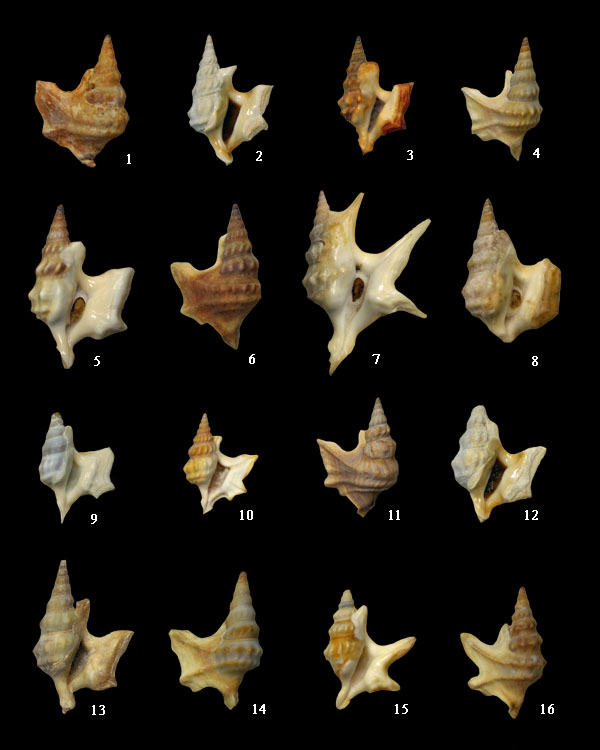 - Aporrhais pespelecani bilobatus (Clement,1875); Le Pô, Carnac, Baie de Quiberon, Morbihan Department, France; in oysterfarm, 4/1974; Coll. UW1615
- Aporrhais pespelecani bilobatus (Clement,1875); Henningsvaer, Austvågøy Island, Lofoten Archipelago, Nordland County, Norway; 2-6 m, 1989; Coll. UW1405
- Aporrhais pespelecani bilobatus (Clement,1875); Farol, Culatra Island, Algarve Region, Portugal; Coll. UW1250
- Aporrhais pespelecani bilobatus (Clement,1875); South of Island; by fisherman; 8/1971; Coll. UW1551
- Aporrhais pespelecani bilobatus (Clement,1875); NW of Portugal; by fisherman; deep water, 1999; Coll. UW1953
- Aporrhais pespelecani bilobatus (Clement,1875); NW of Portugal; by fisherman, deep water, 1999; Coll. UW1952
- Aporrhais pespelecani pespelecani (Linnaeus, 1758); Aberdeen, Aberdeen City Council area, East Scotland; Coll. UW1804
- Aporrhais pespelecani bilobatus (Clement,1875); Waterford, Waterford County, Munster Province, Ireland (Eire), Irish Sea; by fisherman, 7/1985; Coll. UW1623
- Aporrhais pespelecani bilobatus (Clement,1875); South of Island; by fisherman, 8/1971; Coll. UW1550
- Aporrhais pespelecani bilobatus (Clement,1875); Skagerrak Strait, Denmark; by fisherman, 6/1996; Coll. UW834
- Aporrhais pespelecani bilobatus (Clement,1875); Skagerrak Strait, Denmark; by fisherman, 6/1996; Coll. UW837
- Aporrhais pespelecani bilobatus (Clement,1875); North Sea fishery, between Shetland Islands and Lofoten Archipelago(?); 1990; Coll. UW815
- Aporrhais pespelecani bilobatus (Clement,1875); Cardigan Bay, Wales, Irish Sea; 150 m; Coll. UW1582
- Aporrhais pespelecani bilobatus (Clement,1875); Dogger Bank sandbank, North Sea, east coast of England; by fisherman, 7/1969; Coll. UW1589
- Aporrhais pespelecani pespelecani (Linnaeus, 1758); Scheveningen District, The Hague, South Holland Province, The Netherlands; 1988; Coll. UW972
- Aporrhais pespelecani pespelecani (Linnaeus, 1758); Spuikom, Ostend, West Flanders Province, Flemish Region, Belgium; in Oysterfarm, 1974; Coll. UW1553
Specimen 16 from Oostende (Belgium) is the Mediterranean form. It was found together with several other specimen in an oysterfarm. Following Kermarrec-Labisse, 1968, this form is introduced into the North Sea by importing young oysters from the Mediterranean Sea. Maybe this explains also the two other Mediterranean specimen 7 and 15 in the North Sea.
Aporrhais pespelecani bilobatus (Clement, 1875); Portmanock, Fingal County, Leinster Province, Ireland (Eire), Irish Sea; 9/1960; Ex-coll. U.Hecker; Coll. NMMz
- subadult, 48 mm
- subadult, 41 mm
- adult, 40 mm
Aporrhais pespelecani bilobatus (Clement, 1875); beach "Ellenbogen" (55°03'29.0"N 8°25'08.1"E), Sylt, Schleswig-Holstein State, Germany; beached; 35 mm; 9/2014; Coll. Henning Pfeifer
Aporrhais pespelecani bilobatus (Clement, 1875); St. Peter Ording, Germany; 36 mm; 1980s; Coll. Manuel Pietzonka, exColl. Andreas Kolb
Aporrhais pespelecani bilobatus (Clement, 1875); La Rochebonne Bank, Bay of Biscay, Gironde Department, France; trawled at 80 m; 1985; Coll. René Vanwalleghem
- 44 mm
- 47 mm
- 43 mm
- 45 mm
Aporrhais pespelecani (Linnaeus, 1758); Bay of Biscay, Gironde Department, France; trawled at 120 m; Coll. Clint Vanleke
Aporrhais pespelecani bilobatus (Clement, 1875); off Lundy Island, Bristol Channel, Devon County, South West Region, England; trawled at 30/40 fms; 1989; Coll. René Vanwalleghem
- 49 mm
- 43 mm
- 50 mm
Aporrhais pespelecani (Linnaeus, 1758); Portugal; 40,1 mm; Coll. Chong Chen
Aporrhais pespelecani (Linnaeus, 1758); Gulf of Saros, Turkey, North Aegean Sea; from fishermen nets, 15.07.2019; Coll. Yücel Mollaoglu
Some strange forms of Aporrhais pespelecani (Linnaeus, 1758); freaks:
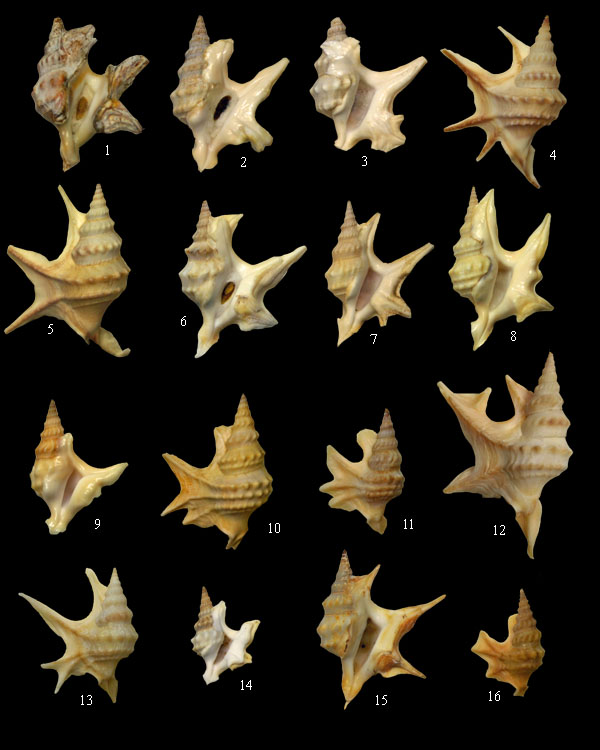 - "Senile" specimen, Fiumicino, Metropolitan City of Rome, Lazio Region, Italy; 80-200 m sandy bottom, by fisherman, 2000
- Lisbon, Lisbon Region, Portugal; 1989
- East coast of Sithonia, Chalkidiki Peninsula, Central Macedonia Region, Greece; beached, 1982; Coll. UW1379
- Malaga, Malaga Province, Autonomous community of Andalusia, Spain; by fisherman, 30-40m, 5/2000; Coll. UW2085
- Fiumicino, Metropolitan City of Rome, Lazio Region, Italy; 80-200 m sandy bottom, by fisherman, 2000; Coll. UW1976
- Thessaloniki, Central Macedonia Region, Greece; Coll. UW1559
- East coast of Sithonia, Chalkidiki Peninsula, Central Macedonia Region, Greece; beached, 1982; Coll. UW1380
- Benicarlo, Castellon Province, Valencian Autonomous community, Spain; by fisherman; Coll. UW793
- Malaga, Malaga Province, Autonomous community of Andalusia, Spain; by fisherman, 30-40m, 2/1995; Coll. UW2063
- Fiumicino, Metropolitan City of Rome, Lazio Region, Italy; 80-200 m sandy bottom, by fisherman, 2000; Coll. UW2015
- Malaga, Malaga Province, Autonomous community of Andalusia, Spain; by fisherman, 30-40m, 7/1994; Coll. UW1967
- Malaga, Malaga Province, Autonomous community of Andalusia, Spain; by fisherman, 30-40m, 2/1995; Coll. UW1968
- Malaga, Malaga Province, Autonomous community of Andalusia, Spain; by fisherman, 30-40m, 10/2001; Coll. UW2069
- Sesimbra, Setúbal District, Portugal; deep water; Coll. UW852
- Torrevieja, Alicante Province, Valencian Autonomous community, Spain; by fisherman, 7/1973; Coll. UW1555
- Malaga, Malaga Province, Autonomous community of Andalusia, Spain; by fisherman, 30-40m, 10/2001; Coll. UW2084
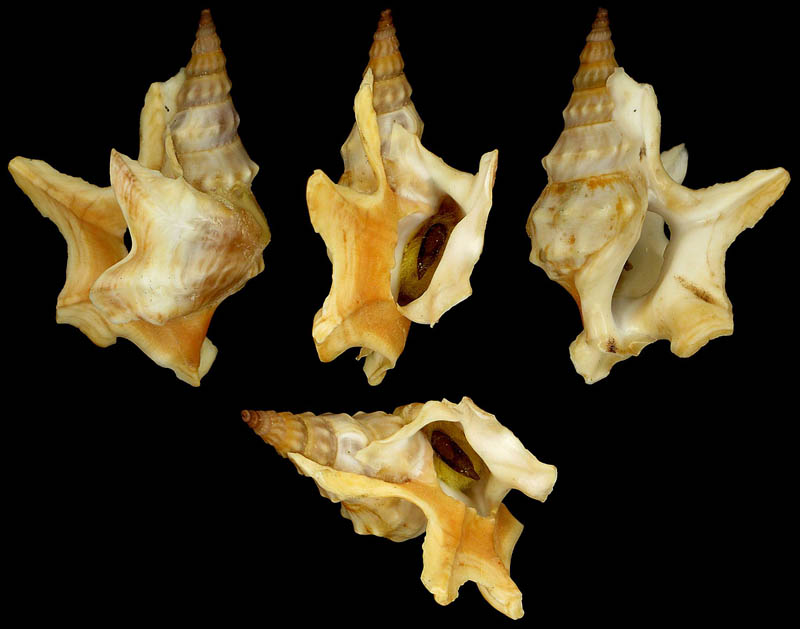 Aporrhais pespelecani (Linnaeus, 1758); freak; Coll. Andrea Nappo
Aporrhais pespelecani (Linnaeus, 1758); Benicarlo, Castellon Province, Valencian Autonomous community, Spain; 58,7 mm; Coll. Don Pisor
Aporrhais pespelecani (Linnaeus, 1758); Vassiliki, Lefkada island, Gulf of Patras (Patraikos Gulf), Ionian Islands Region, Greece, Ionian Sea; from fishermen nets; 2009; Coll. George Bazios
Aporrhais pespelecani (Linnaeus, 1758); Vassiliki, Lefkada island, Gulf of Patras (Patraikos Gulf), Ionian Islands Region, Greece, Ionian Sea; from fishermen nets; 2009; Coll. George Bazios
Aporrhais pespelecani (Linnaeus, 1758), juvenile; Saronic Gulf, Greece; 2019; photo and Copyright Constantinos Kontadakis
In Holocene and Pleistocene there is a form found in the North Sea that is very similar to the recent Aporrhais pespelecani bilobatus. It can be found on Schiermannigkoog and Ameland. Those shells might come from Eemian (De Boer & de Bruyne, 1991)
Aporrhais pespelecani bilobatus (Clement, 1875); Eemian, Holocene; Raise site 't Kalf, Zaandam, The Netherlands; 9/1969; Coll. Han Stoutjesdijk no. 2388a
- 23 mm
- 20 mm
Aporrhais pespelecani (Linnaeus, 1758); The Netherlands, 2012; Coll. Eric Vanloo
La Rochebonne Bank, Bay of Biscay, Gironde Department, France; trawled in 80 m; 7/1985; Coll. René Vanwalleghem
- Aporrhais pespelecani dead, mouth is the home of the worm Phascolion strombi.
- Montacuta phascolionis, a bivalve living inside dead Aporrhais pespelecani (and other gastropods like Turritella communis) together with Phascolion strombi.
- Evalea diaphana, a small pyramidellinid sometimes living in dead Aporrhais pespelecani together with Phascolion strombi. There seems to exist a morphological different form of Evalea diaphana living outside dead Aporrhais pespelecani.
- see also Fish & Fish, 1996
Aporrhais pespelecani (Linnaeus, 1758); "poorten vismijn", Ostend, West Flanders Province, Flemish Region, Belgium; 2012; Coll. Clint Vanleke
In the Pliocene of the North Sea basin Aporrhais pespelecani is found. It is called Aporrhais pespelecani quadrifida (Marquet, 1998), but there are doubts that this name is correct. It is shown on the following picture:
Strombus pespelecani (Linnaeus, 1758); Pliocene; Piacenza, Piacenza Province, Emilia-Romagna Region, Italy; Coll. Goldfuss-Museum Bonn
Aporrhais pespelecani (Linnaeus, 1758); lower Pliocene; Harokopio near Koroni, Messenia Regional unit, Peloponnese Region, Greece; Coll. Hochleitner
Aporrhais pespelecani (Linnaeus, 1758); upper Pliocene; Glykovrissi, Laconia Regional unit, Peloponnese Region, Greece; 30 mm: Coll. Hochleitner
Aporrhais pespelecani (Linnaeus, 1758); upper Pliocene; Glykovrissi, Laconia Regional unit, Peloponnese Region, Greece; Coll. BSPG no. 2004 X 117
Aporrhais pespelecani (Linnaeus, 1758); Pliocene; Chero River, Piacenza Province, Emilia-Romagna Region, Italy; 25 mm; Coll. Stefano Granelli
Aporrhais pespelecani (Linnaeus, 1758); freak; Pleistocene; Stirone River, Piacenza Province, Emilia-Romagna Region, Italy; 50 mm; Coll. Vecchia; Photo Stefano Granelli
- Comment: The fourth digit reminds of Aporrhais serresiana
Aporrhais pespelecani (Linnaeus, 1758); Pleistocene; Stirone River, Piacenza Province, Emilia-Romagna Region, Italy; 46 mm; Coll. Vecchia; Photo Stefano Granelli
Aporrhais pespelecani (Linnaeus, 1758); Scaldisian?, Pliocene?; Antwerp, Belgium; 29 mm; Coll. Paläontologisches Museum Nierstein
Chenopus anglicus d'Orbigny, 1852; Coralline Crag, Zanclean, lower Pliocene; near Orford Castle, Suffolk County, East Region, England; 24,5mm; Coll. Philippe Simonet
Miocene Aporrhais pespelecani
Aporrhais aff. pespelecani dertominor Sacco, 1893; Tortonian/Messinian, upper Miocene; Stazzano, Alessandria Province, Piedmont Region, Italy; 17,0 mm; Coll. Ulrich Wieneke
Aporrhais cf. pespelecani (Linnaeus, 1758); Serravallian, middle Miocene; Lale, Karaman, Turkey; Coll. Stichting Schepsel Schelp HES 14309
Biology
Aporrhais pespelecani is living on relative firm muddy gravel bottoms in depth from 10 to 200 m. The locomotion of Aporrhais pespelecani is a movement, as if it would run with sprags. It is described in Haefelfinger, 1968 and Kronenberg, 1991
Etymology: Named by Carl von Linne as Strombus pes-pelecani. "Pes pelecani" means foot of the pelican.
References
- Brocchi, 1814
- Bronn, H.G. 1834-1838. Lethaea geognostica oder Abbildungen und Beschreibungen der für die Gebirgs-Formationen bezeichnendsten Versteinerungen; Stuttgart, 1835-1838 [i.e. 1834-1838], Vol. 1, pp. 1-96, 1834; 97-192, 1835; 193-288, 384 & 480, 1836; 481-544, 1838 (?1837). Vol. 2. pp. 544-768, 1837; 769-end, 1838, Fulltext
- Bucquoy, E., Dautzenberg, P. & Dollfus, G. (1882-1886). Les mollusques marins du Roussillon. Tome Ier. Gastropodes. Paris: Baillière & fils. 570 pp., 66 pls. [pp. 1-84, pls 1-10, 1882; pp. 85-196, pls 11-20, 1883; pp. 197-342, pls 21-40, 1884; pp. 343-418, pls 41-50, 1885; pp. 419-570, pls 51-66, 1886], https://doi.org/10.5962/bhl.title.12671
- Clement,C. 1875. Catalogue des Mollusques du Gard; Bulletin de la Société d'étude des sciences naturelles de Nîmes, IV-44 p., URL: https://gallica.bnf.fr/ark:/12148/bpt6k1091414c
- da Costa, 1778
- Fish, J.D. & Fish, S., (1996). A student's guide to the seashore. Second edition. Cambridge: Cambridge University Press.
- (Fontannes, 1880)
- Hörnes, M. 1851-56. Die fossilen Mollusken des Tertiär-Beckens von Wien. I. Univalven. Abhandlungen der Kaiserlich-Königlichen Geologischen Reichsanstalt 3: 1–736, pls. 1–52. [1–42, pls. 1–5 (1851); 43–184, pls. 6–15 (1852); 185–296, pls. 16–32 (1853); 297–384, pls. 33–40 (1854); 385–460, pls. 41–45 (1855); 461–736, pls. 46–52 (1856).], Fulltext
- Johansson, J. 1948. Über die Geschlechtsorgane von Aporrhais pespelecani nebst einigen Betrachtungen über die phylogenetische Bedeutung der Cerithiacea und Architaenioglossa. Arkiv för Zoologi, 41A,8, 1-13.
- Kantor et al., 2008
- Kobelt, W., 1887-1908. Iconographie der schalentragenden europäischen Meeresconchylien, Cassel, T. Fischer. [4. Band, 1908]
- Locard, A. 1886, Prodrome de malacologie francaise. Vol. 2 Catalogue général des mollusques vivants de France: mollusques marins. Lyon, Henri Georg. X, 778 pp.
- Locard, A. 1892, Les coquilles marines des cotes de France. Description des familles, genres et espèces. Paris: J.B. Baillière et Fils. 384 pp., 348 text figs.
- Müller, O.F. 1789. Zoologia Danica Sev Animalivm Daniae Et Norvegiae Variorvm ac Minvs notorvm Descriptiones et Historia, vol. 3, Havniae, Mölleri et filii; [unnumbered pp. 3], 1-71, pls. LI-CXX, URL: http://resolver.sub.uni-goettingen.de/purl?PPN614794331
- Risso, 1826
- Rothpletz, A. & Simonelli, V. (1890). Die marinen Ablagerungen auf Gran Canaria. Zeitschrift der Deutschen geologischen Gesellschaft, 42 (4): 677–736, Fulltext
- Scilla, 1759
- Sergey Snigirov, Roman Sizo and Sergiy Sylantyev (2013). Lodgers or tramps? Aporrhais pespelecani and Turritella communis on the north-western Black Sea shelf. Marine Biodiversity Records, 6, e119 doi:10.1017/S1755267213000900.
- Sowerby, 1859
- Yonge 1937
- Lebour 1933
- newFilippi 1987
Sequences:
Internet
|

